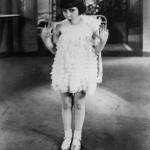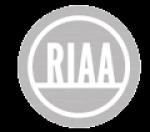前回 は、大恐慌時代の1930年代前半、WE特許使用料回避のため生まれたBlumleinシステムや、当時のRCA VictorやColumbiaの状況など、あれこれについて調べました。
On the previous part, I studied on the history of the improvement of disc recording technology for commercial discs, including the Blumlein system, situations of RCA Victor and Columbia in the 1930s (during the Great Depression), etc.
今回は、民生用ではなく、映画用・放送局向けのレコード技術 の話、そして初めてS/N比向上の目的で 意識的に高域プリエンファシスが用いられた録音技術 について学んでいきます。
This time, I am going to continue learning the history, from the disc recording technology for professional talking motion pictures and broadcast stations (not regular records for consumer market), and the very important technology that consiously used treble pre-emphasis for the first time in history, to increase S/N ratio.
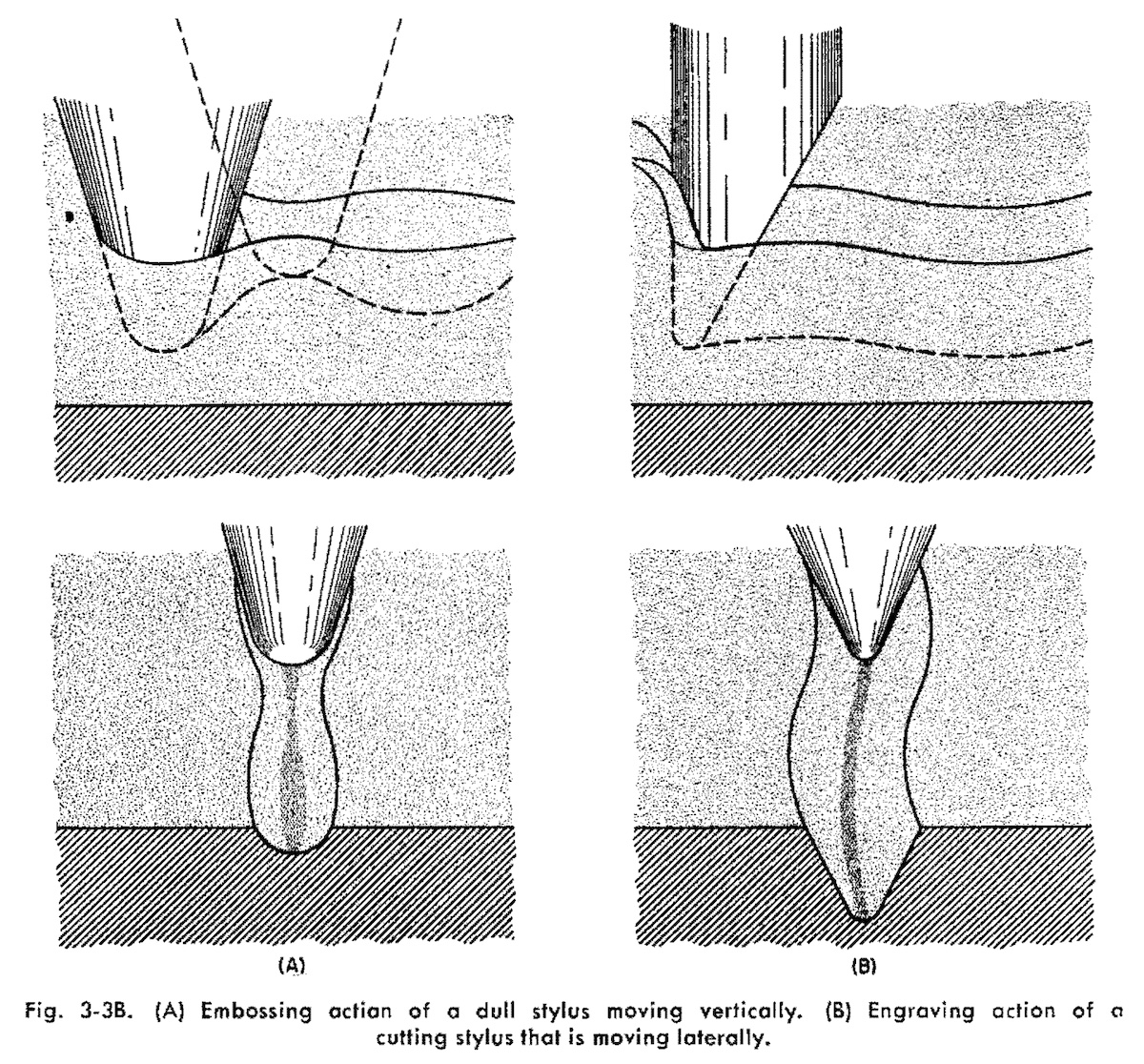
source: “The Recording and Reproduction of Sound”, Oliver Read, 2nd Edition, 1952, p.21, Fig. 3-3B.
縦振動記録(左)と横振動記録(右)の比較
「Pt.0 (はじめに)」、「Pt.1 (定速度と定振幅、電気録音黎明期)」、「Pt.2 (世界初の電気録音、Brunswick Light-ray、ラジオ業界の脅威)」そして「Pt.3 (Blumlein システム、当時のRCAやColumbia、民生用における高域プリファレンスの萌芽)」の続きです。
This article is a sequel to “Things I learned on Phono EQ curves, Pt.0”, “Pt.1”, “Pt.2” and “Pt.3”.
前回も書きましたが、筆者自身の学習過程を記したものですので、間違いの指摘や異論は遠慮なくお寄せください。
As I noted in the previous article, this is the footsteps of my own learning process, so please let me know if you find any mistakes on my article(s) / if you have different opinions.
今回も相当長い文章になってしまいましたので、さきに要約を掲載します。同じ内容は最後の まとめ にも掲載しています。
Again, this article become very lengthy – so here is the summary of this article (the same contents are avilable also in the the summary subsection).
元々はトーキー映画の音声用に作られた33 1/3回転の Vitaphone の技術を使い、RCA Victor が市販用に長時間レコード Program Transcription を販売開始したが、当時の技術では問題があり、また大恐慌真っ只中でもあり、ほどなく回収された。一方、ラジオ局を中心に16インチトランスクリプションが多く使われるようになり、事実上業界標準のメディアとなった。
RCA Victor’s long playing 33 1/3 “Program Transcription” discs and associated players debuted for commercial customers, using the technology of Vitaphone, a successful soundtrack system for moving pictures. However, “Program Transcription” system had several defects, and it was during the Great Depression. So it was abandoned a few years later. On the other hand, this 33 1/3 coarsegroove disc technology survived as Radio Station Transcription discs and became an industry standard.
1931年に登場した民生用の RCA Victor 長時間レコード Program Transcription 盤では、Victrolac (Vitrolac) という新素材を使った盤が使われた。のちのヴァイナル盤につながる合成樹脂で、これにより盤が軽量化し、割れにくく、サーフェスノイズも減った。ただし、当時主流だった重いピックアップと鉄針では、盤がすぐに痛んでしまった。
RCA Victor’s long playing Program Transcription records (for consumer market, debuted in 1931) used Victrolac compound, which was the first attempt to use symthetic resin for disc records like vinyl records of PVC compound in later years. Victrolac disc was lightweight, unbreakable and with less surface noise. However, because of the heavy pickup and steel needle (that was very common in those days), it was worn out very easily.
ほぼ同時期に、Bell Labs / Western Electric が、縦振動記録の新方式を開発、セルロースアセテートにプレスする方式で、当時としては画期的な音質向上に寄与する技術がいくつも採用された。そのなかのひとつが、S/N比向上のために採用された高域プリエンファシスの定義で、現在につらなる録音再生カーブの最初期の例となる。
Also in the early 1930s, Bell Labs / Western Electric developed a new “hill-and-dale” (vertical) recording system and acetate pressing. This system adopted many technical innovations that contributed sound quality improvements. One of them was the introduction of intentional treble preemphasis, that was one of the early example of modern recording/reproducing EQ curve.
また、縦振動トランスクリプションでは、1938年にモーショナルフィードバック回路を備えたカッターヘッドが開発され、フラット記録が可能となった。この時点で初めて、録音EQカーブが独立した装置で設定されるようになり、通常の横振動レコードの10年近く先を行く画期的な発明であった。
Bell/WE also invented the feedback cutter for vertical transcription system, that accomplished flat frequency response recording. This technology, for the first time in history, opened the door that the recording EQ became independent from cutterhead’s characteristic. It was such an innovation that made the system nearly ten years ahead of lateral recording system.
Contents / 目次
- 4.1 “Vitaphone” for Talking Motion Pictures / トーキー映画用「ヴァイタフォン」
- 4.2 “Program Transcription” Record (coarse groove, 33 1/3 rpm)
- 4.3 Birth of “Electrical Transcription” Records / トランスクリプション盤の誕生
- 4.4 Bell Labs / WE’s “Hill-and-dale” Transcription / ベル研/WEの縦振動トランスクリプション
- 4.5 The summary of what I got this time / 自分なりのまとめ
4.1 “Vitaphone” for Talking Motion Pictures / トーキー映画用「ヴァイタフォン」
少し時代を遡って1926年に戻ります。
Now we are going back in time a little bit, to 1926.
第二次大戦後に LP で一般的となる 33 1/3回転 という回転数は、Bell Labs / Western Electric と Warner Bros. が1926年に実用化したヴァイタフォン (Vitaphone) が史上初でした。当初使われていた材質は市販用の78rpmより硬質なものの、シェラック盤だったそうです。溝はまだマイクログルーヴ (microgroove, fine groove) ではなく、従来の幅の溝 (coarse groove) でした。
The first application of 33 1/3rpm – that became popular and standard with the advent of Long Playing microgroove records after the WWII – was the Vitaphone, a sound film system (with sound-on-disc), developed by Bell Labs / Western Electric and Warner Bros. in 1926. Initially, Vitaphone discs are made of hard shellac, unlike modern vinyl compounds. Also, it was coarse groove (like ordinary 78rpms), not fine groove (aka microgroove, like LPs and 45rpms).

source: Wikimedia Commons. Public Domain.
Western Electric 技術者による、Vitaphone 再生デモ
これは、トーキー時代突入直後の映画で使われたシステムで、16インチ 33 1/3回転に片面11分程度記録可能だったそうです。Al Jolson 主演の有名な作品 “The Jazz Singer” (1927) もこのヴァイタフォンによって制作されたトーキー映画です。
This system used 16-inch 33 1/3 rpm disc that holds eleven minutes of sound per side, and the Vitaphone system was frequently used in the early “talkie” moving pictures. One of the famous films with this technology was “The Jazz Singer” (1927), starring Al Jolson.
1897年設立の老舗映像制作会社 Vitagraph 社 (Vitagraph Co. of America) を、1925年4月に Warner Bros. 社が買収したことにより、その名にちなんで映像用音声システムを Vitaphone と名付けたものと想像されます。
Vitagraph Co. of America, founded in 1897, a prolific film production company, was bought by Warner Bros. in April 1925. So the brand name “Vitaphone” probably derived from the company name “Vitagraph”.
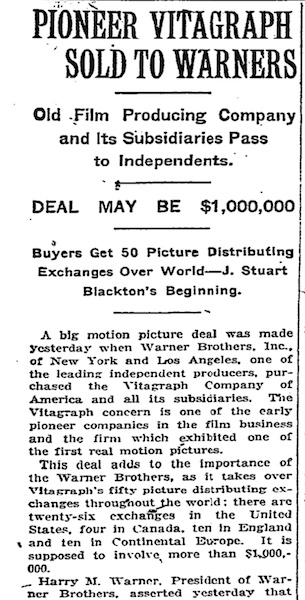
source: “Pioneer Vitagraph Sold to Warners”, The New York Times, April 23, 1925, p.24.
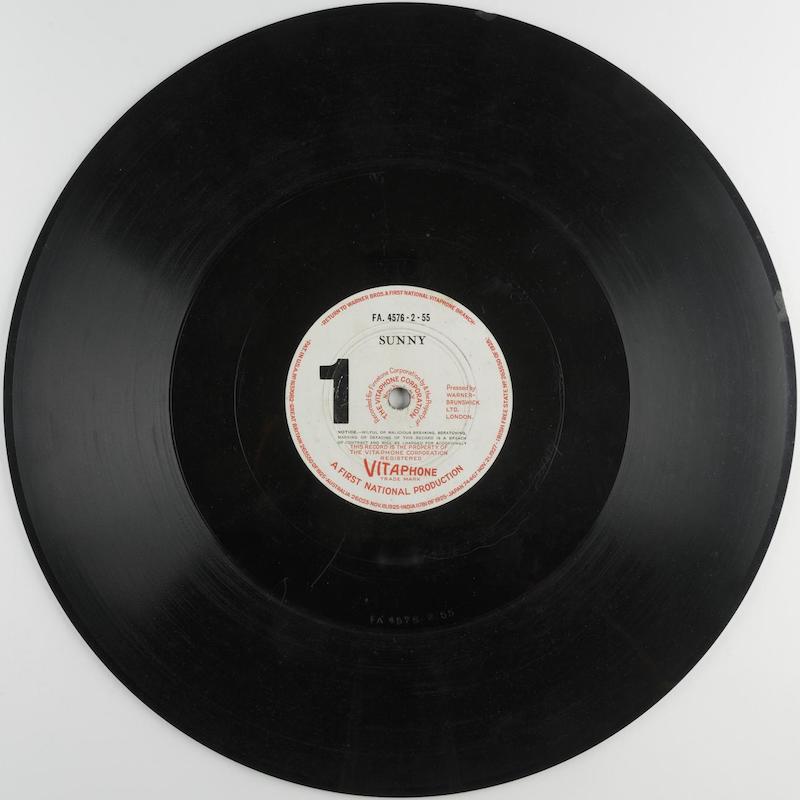
source: https://collection.sciencemuseumgroup.org.uk/objects/co8606388/vitaphone-disc-for-sound-film-sunny-1930-usa-vitaphone-disc/, © The Board of Trustees of the Science Museum, London, CC BY-NC-ND 4.0
1926 – One of the first Vitaphone shorts was made with Bryan Foy in the Manhattan Opera House in New York, with subway noise frequently interrupting the recording, according to mixer George Groves.
Vitaphone used a 12-inch or a 16-inch disc on a turntable geared to a projector with a Western Electric 4-A pickup, at 33-1/3 rpm for 9-10 minutes, from inside to outside, on one side only, with a lateral-cut groove.
Victor made the Vitaphone records with much less abrasive filler, causing the discs to wear out after only 24 plays. Vitaphone discs had a needle force of 3-6 ounces and frequency response of 4300 Hz. The Fox sound-on-film was 8000 Hz but had more wow and flutter and more noise caused by light cell reading film emulsion grain.
1926年:Bryan Foy監督と共に、ニューヨークのマンハッタンオペラハウスで最初期のヴァイタフォン(Vitaphone)ショートムービーが製作された。製作は地下鉄の騒音によって頻繁に中断された、とミキサーを担当した George Groves の弁。
ヴァイタフォンは12インチまたは16インチのディスクを、映写機とギアで同期されたターンテーブル上で使うものであった。再生は Western Electric 4-A ピックアップを使い、33 1/3回転で9〜10分の再生が可能であった。インサイドアウト(盤の内側から外側に向けて記録再生)、片面のみのディスクで、横振動による記録方式であった。
Victor が製造したヴァイタフォンレコードは、抗摩耗剤の配合を非常に少なくしていたため、たった24回再生しただけでディスクが摩耗してしまった。針圧は3オンス(約85グラム)〜6オンス(約170グラム)で、再生可能な最高周波数は4,300Hz であった。Fox 社の sound-on-film では 8,000Hz まで再生できたが、フイルム上の乳剤粒子をライトセルが読み取ってしまうため、ワウフラッターが多く発生し、ノイズも大きくなってしまっていた。
Motion Picture Sound - part 1, 1910-1929上記の引用にも書かれている通り、20回ほどの再生で溝の摩耗が音にで始めるため、現存する当時のヴァイタフォンのレーベルを見ると、再生回数をチェックする枠が印刷されているものもあります。寿命がきたら、新しいヴァイタフォンで再生を続け、摩耗した盤は送り返す仕組みになっていたそうです。
As the above quote says, discs started to suffer from audible wear after an estimated 20 playing, so some of the Vitaphone records’ label has a checking squares to note how many times it had been played. After the disc worn out, a new set of Vitaphone records were used for the screening, and the old set was sent back to the record manufacturers.
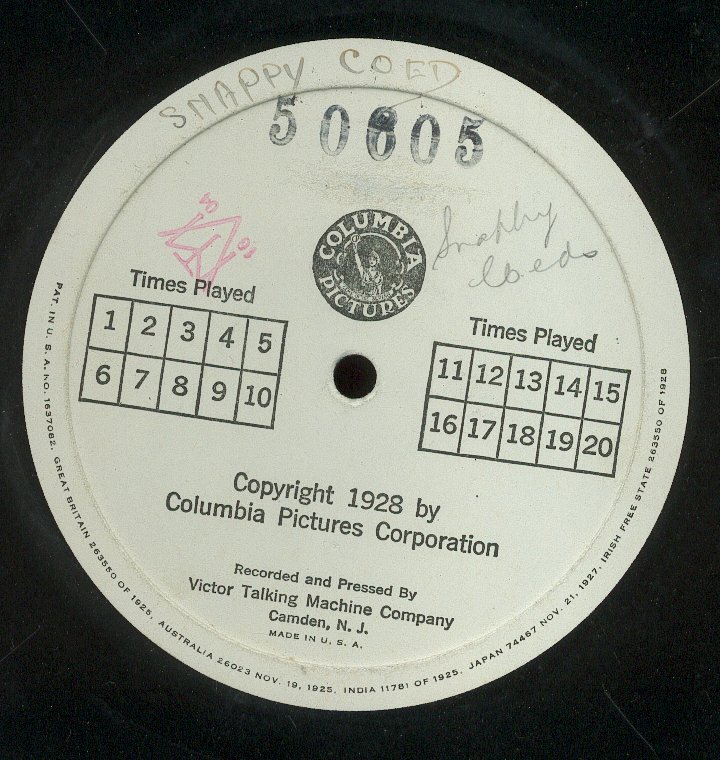
source: “Ron Hutchinson’s Vitaphone Project: Discoveries Galore!!”.
1928年 “Snappy Coeds” (with Nan Blakstone) 用のヴァイタフォンのレーベル
Vitaphone label for “Snappy Coeds” (with Nan Blackstone), a 1928 sound motion picture.
ヴァイタフォンについては、Wikipedia のページ(英語) が異常に充実していますので、一読をおすすめします。
Wikipedia entry of “Vitaphone” has a whole lot of information – highly recommended.
Peter Monaghan 氏による “A Resounding 25 Years of Reviving Early Film” という記事でも、最初期 Vitaphone のレーベル写真を含め、貴重な情報がまとまっています。
The web article “A Resounding 25 Years of Reviving Early Film” by Peter Monaghan also features the long story about Vitaphone, featuring the label photo of the very early Vitaphone record.
“History of Sound in Film: A Century of Sound Co-Creator Robert Gitt Q&A” という記事では、Vitaphone のワックス原盤の写真も見ることができます。
Another web article “History of Sound in Film: A Century of Sound Co-Creator Robert Gitt Q&A” below features the photo of the wax master disc for Vitaphone.
4.2 “Program Transcription” Record (coarse groove, 33 1/3 rpm)
一方、RCA Victor が市販用に発表し、1931年9月から大々的に宣伝された、世界初の民生用長時間レコード「Program Transcription」(12インチ 33 1/3回転)があります(放送局用の Electrical Transcription Record とは異なることに注意)。
On the other hand, another remarkable topic by RCA Victor would be “Program Transcription”, 12-inch 33 1/3 rpm records, the world’s first long playing records for consumer market (please note that Program Transcription records are different from Electrical Transcription records for radio broadcast). It was advertised extensively starting from September 1931.
ヴァイタフォン (Vitaphone) 同様、溝はマイクログルーヴ (fine groove) ではなく、従来のレコードと同じ太い溝 (coarse groove) 、正確には通常の78回転盤よりほんの少し狭めの太い溝、ですが、最大で片面15分(両面30分)収録可能で、当時は民生用に専用の(78回転と33 1/3回転の両方に対応する)電蓄も販売されていました。最初にリリースされたのは RCA Victor L-7001、Stowkowski 指揮、フィラデルフィア管弦楽団によるベートーヴェン 交響曲 第5番 ハ短調「運命」でした。
Like Vitaphone, the groove of this format was not microgroove (fine groove), but widegroove (coarse groove), although it actually was a bit narrower than widegroove. It could hold 30 minutes of music (15 min each side) at most, and dedicated phonograph players (that can play both 78 rpm and 33 1/3 rpm) were sold for consumer market. The first title released was RCA Victor L-7001, Beethoven’s Symphony No.5 in C Minor, Leopold Stokowski conducting the Philadelphia Orchestra.
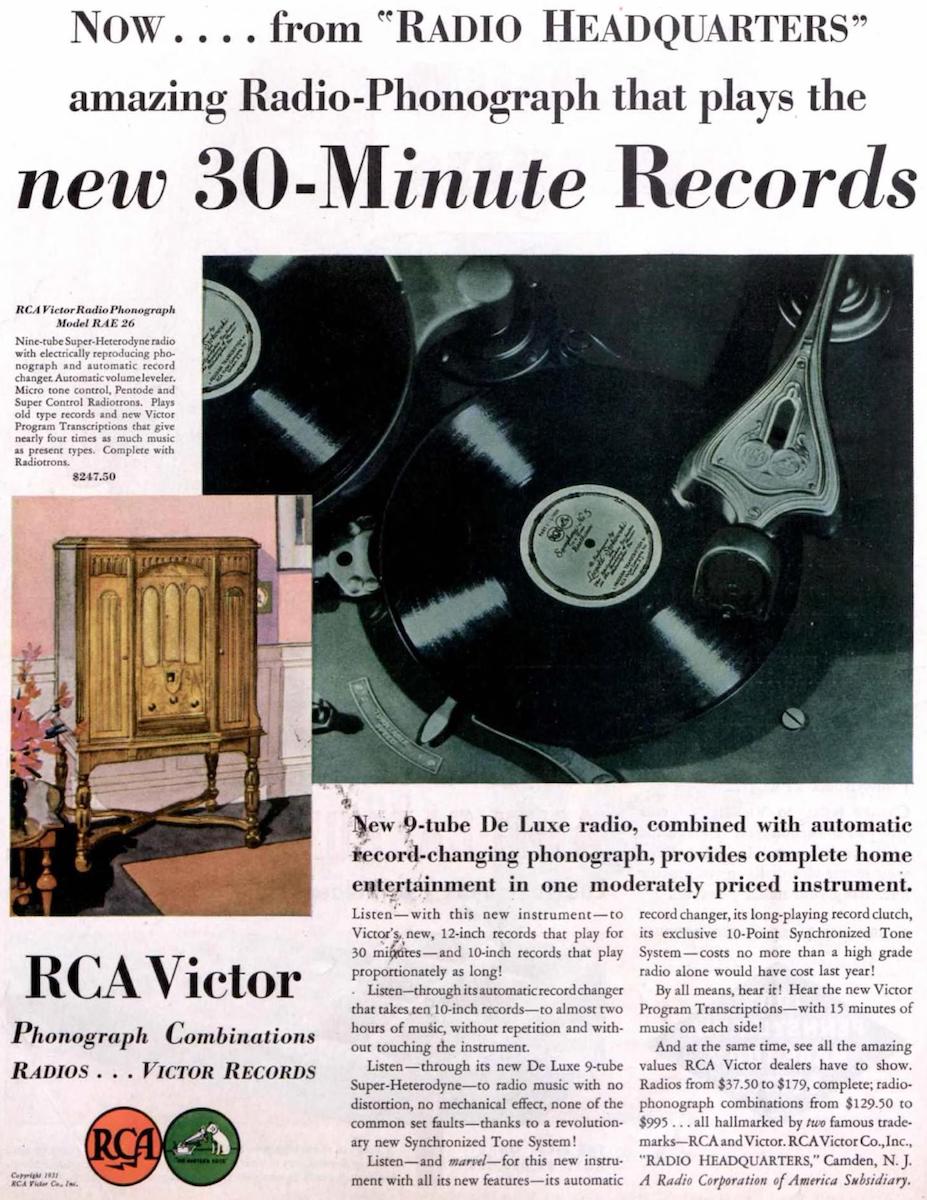
source: RCA Victor brouchure, 1931, archived at hifi-archiv.info
1931年のRCA Victorのパンフレット、78rpm + 33 1/3rpm 両対応の民生用蓄音機 Radiola Automatic Electrola RAE-26 も掲載
RCA Victor brochure from 1931: also featuring Radiola Automatic Electrola RAE-26, compatible both with 78rpm and 33⅓ rpm
実は、この Program Transcription、当ブログに以前書いた「Feb. 3, 1932: The First Stereo Sound Recording Known To Exist」にも登場していたものです。
A dozen of years ago I wrote about the Program Transcription under the title “Feb. 3, 1932: The First Stereo Sound Recording Known To Exist”.
ちなみに、「Feb. 3, 1932: The First Stereo Sound Recording Known To Exist」で紹介したメドレー2枚は、L-16006 と L-16007 という Program Transcription 盤(片面盤)として当時リリースされたものです。
For what it’s worth, two Ellington medleys (that I mentioned in my past article “Feb. 3, 1932: The First Stereo Sound Recording Known To Exist”) are released as Victor L-16006 and L-16007 single-sided Program Transcription records.
1931年にデビューした民生用の Program Transcription は、従来のシェラックではなく、Jim Hunter 氏が開発した “Victrolac” (または “Vitrolac”) というビニル化合物で製造されており、当時の重い針圧(150g〜200g 程度が普通)で再生すると、数回の再生で溝の底を痛めてしまったり、微細な記録溝を壊してしまう問題がありました。
Program Transcription discs, debuted in 1931 for consumer market, were not made from shellac. Instead, they were made from a vinyl compound named “Vitrolac” (or “Victrolac”), developed by Jim Hunter. Unfortunately, most of the phonograph pickups, even special ones dedicated to Program Transcription discs, were so heavy (normally 150g to 200g) that they cut through the material (and scrape delicate groove walls) after several plays.
そのため顧客からのクレームも少なくなく、また当時は大恐慌時代真っ只中であり、1933年までには市場から回収されてしまいました。
Then came a good amount of complaints from customers, so RCA Victor decided to withdraw the records on the market by 1933. Again, it was also during the Great Depression.
RCA had made them in 1932 (NOTE: 1931 is correct) and, as a matter of fact, when I became general manager of the Victor Division of RCA on July 1, 1933, my first act was to take them off the market. The idea was good and they might have sold, but there were technical problems. Most of the records were made from Victorlac, a vinyl compound developed by Jim Hunter; the pickups available at that time were so heavy they just cut through the material after several plays. The complaints from customers all over the U.S. were so terrific that we were forced to withdraw the LPs. If you could get a new pressing of one of these records today and play it with a modern lightweight 2-mil pickup, it probably would sound pretty good.
1932年に(訳註:正確には1931年です)RCA は長時間再生レコードを販売した。そして、1933年7月1日に私がRCAのVictor部門のジェネラルマネージャに就任した際、最初に行ったことは、その長時間レコードを市場から回収することであった。アイデアは確かによかったし、そこそこ売れたが、技術的な問題があった。その長時間レコードのほとんどは Jim Hunter が開発したビニル化合物である Victrolac で作られていたが、当時のピックアップは重すぎて、数回再生しただけでレコードを傷つけてしまった。全米中の顧客からの不平不満は大変なもので、市場から引き上げざるをえなかった。もし当時の長時間レコードで未再生の盤をこんにち入手できたならば、現代の軽量ピックアップで(かつ針は2milで)再生すれば、非常に素晴らしい再生音を得られるだろう。
“Creating the LP Record”, by Edward Wallerstein as told to Ward Botsford, High Fidelity Magazine”, p.57, April 1976.民生用としては大失敗に終わった Program Transcription 盤でしたが、この従来の溝 (coarse groove) + 33 1/3回転、Victrolac 製、という組み合わせは、16インチのサイズとなり、ラジオ局で使用されるトランスクリプションディスクとして業界標準となっていきます。4.3節から、そのあたりに触れていきます。
Program Transcription (for consumer market) resulted in miserable failure. However, the combination of coarse groove, 33 1/3 rpm and Victrolac soon became the radio industry’s de facto standard as 16-inch radio transcription discs, that will be featured below.
先程迄 爆睡していました…(+_+)
— 白石 功 (@75Shira) March 6, 2020
ありましたヽ( ・∀・)ノ
ビクターの長時間レコード
コロムビアがLPレコード
発表より20年前の1930年代前半 33回転1/3のレコードがありました 溝がぼろぼろで再生出来ないので 次回の配信でチラ見せ
します…ヽ(・ω・)ノ pic.twitter.com/o9c1AFMtYK
4.2.1 “Vitrolac” (or “Victrolac”) vinyl compound / “Victrolac” ビニル化合物の誕生
Program Transcription 盤で採用された、“Victrolac”(または “Vitrolac”)と呼ばれる、シェラック混合物に変わる新しい材質は、上で触れた通り、当時の重いピックアップには不適切だったかもしれませんが、音質向上に大きく貢献しました。天然樹脂であるシェラックを主とした化合物から、現代の主流であるポリ塩化ビニル(PVC)を主とした化合物への移行を先取りしていました。
The new material “Victrolac” (or “Vitrolac”), that replaced shellac compound for use with Program Transcription discs, did not work nicely with heavy pickups that were common in these days, although Victrolac surely contributed better sound fidelity. It was a very first step of the transition from the use of natural resin (shellac) to the future synthetic resin (PVC).
1931年春に口頭発表後、1932年4月発行の論文誌に掲載された “Journal of the Society of Motion Picture Engineers” 1932年4月号に、RCA Victor の F.C. Barton (Frederick C. Barton) 氏の論文 “Victrolac Motion Picture Records” が掲載されているのを見つけました。
I found the technical paper entitled “Vitrolac Motion Picture Records”, initially presented at the Spring of 1931, then published on the Apr. 1932 issue of “Journal of the Society of Motion Picture Engineers”. The author was RCA Victor’s F.C. Barton (Frederick C. Barton).
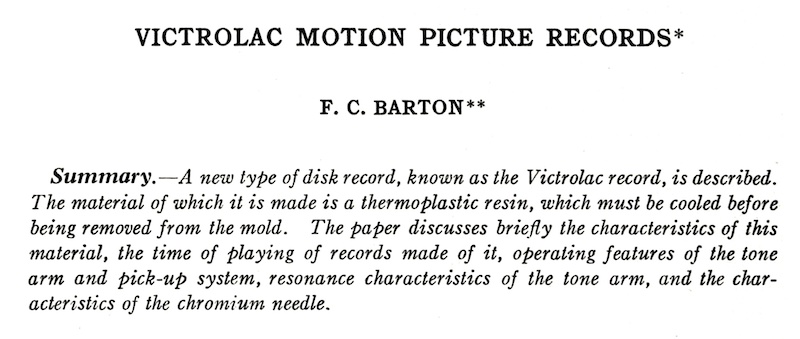
source: “Victrolac Motion Picture Records”, Journal of the Society of Motion Picture Engineers, April 1932, p.452.
Barton 氏の Victrolac 論文のアブストラクト
Abstract section of F.C. Barton’s Victrolac paper.
まさに Victrolac に焦点をあてた技術発表論文ですが、1931〜1932年というタイミングで、いまだに Motion Picture Records というタイトル、つまりトーキー映画用のサウンドトラックとして発表されているのが示唆的です。後述する通り、この時期にはすでに、ディスクによるトーキー映画サウンドトラック「サウンド・オン・ディスク」は、フィルムへの光学録音「サウンド・オン・フィルム」に駆逐され、すでに映画市場の主流ではなくなっていたはずです。
As the title says, this is a technocal paper that concentrates on the Victrolac itself. What’s interesting for me is, it was published under the context of “Motion Picture Records” in 1931-1932. “Sound-on-disc” technology was nearly driven out of Talking Motion Pictures field by optical method “Sound-on-film” technology, so I guess the sound-on-disc was not the major technology in the field anymore.
想像するに、発表できそうな学会が Society of Motion Picture Engineers しかなかったのではないでしょうか(Society of Recording Engineers/Engineering 的なものが存在していたのならばまだしも)。それだけ、レコード盤という技術と文化や市場がどん底にあったことを間接的に感じさせられる気がします。
My conjecture is that, more appropriate scientific societies like, say, kind of “Society of Recording Engineers/Engineering” etc., never existed at that time (The Society of Motion Picture Engineers was the only society that RCA could attend and make presentation of the Victrolac records). It might also indirectly indicate the disc recording technology, culture and market was at the nadir of a recession.
一方、前回の Pt.3でみてきたように、世界恐慌によって、レコード業界は大打撃を受け、録音セッションの数も少なくなり、レーベル職員もミュージシャンも職を失いかねない状況となっていましたので、大恐慌の影響があまりなかった映画産業(およびラジオ産業)へのシフトによって生き残ろうとしたのも理解できますし、本論文が映画技術者向け学会に掲載された背景の1つにあるのでしょう。
On the other hand, as we learned in the previous Pt.3 of my article, the stock market crash in October 1929 led sales dropping of disc record manufacturers and phonograph player manufacturer: many companies going bankrupt; many labels had few recording sessions; many recording engineers lost their jobs at disc recording studios. But motion picture industry was not affected much – musicians and engineers found their new job in the West. This would be another background why this “Victrolac” paper was published on the Journal of the Society of Motion Picture Engineers.
Musicians like the young Benny Goodman, who made a living by playing in recording sessions, found this work ending. Recording engineers found themselves out of work. Happily there were plenty of opportunities for sound technicians on the West coast, where talking pictures were still being made. Discharged employees from the record companies joined song writers, script writers, actors, and agents in the long train ride cross-country to the golden hills of Hollywood.
若かりしベニー・グッドマンのように、録音セッションで演奏することで生計を立てていたミュージシャンは、仕事がなくなることに気づいた。録音技師も仕事がなくなった。幸いなことに、トーキー映画制作が盛んな西海岸では、音響技師に多くの機会があった。レコード会社から解雇された従業員たちは、作曲家、脚本家、俳優、エージェントたちと共に大陸横断の長距離列車に乗り込み、ハリウッドの黄金の丘を目指した。
America on Record: A History of Recorded Sound, 2nd Edition, Andre Millard, 2005, p.166
2022年10月17日追記:
なぜ Victrolac 論文が映画技術の論文誌に掲載されたかについて、Nicholas Bergh さんがコメントを寄せてくれました。以下の文中コラム も併せてご覧ください。
Update on October 17, 2022:
Nicholas Bergh san kindly sent me a comment – his opinion on why the Victrolac paper was in the JSMPE (Journal of the Society of Motion Picture Engineers). Please also take a look at the inline column below for better understanding.
ともあれ、この論文の中身をざっくり見てみましょう。
Anyway, let’s take a brief look at the contents of this paper.
Among the principal advantages is the greatly reduced inherent background or surface noise as compared with former types of record material. In the past it has been found necessary to use a large groove and to record sounds of great amplitude so that the recorded amplitude would be large compared with the amplitude of the surface or scratch noise ; and that by this means the music would mask the surface noise, or at least make it less noticeable. Advantage has been taken of the improved surface conditions of the new material by employing a lower amplitude of recording, smaller grooves, and by placing the grooves closer together, thus increasing the playing time per inch of recorded radius of the record in direct proportion to the increased number of grooves per inch, which in this case is from 90 lines per inch on the old records to 120 or 130 lines per inch on the new records…
(Victrolac の)主な利点としては、以前のタイプのレコードの素材に比べて、サーフェスノイズを大幅に減少できることが挙げられる。従来(のシェラック盤)は、(材質が荒いため)サーフェスノイズが大きく、そのサーフェスノイズをマスクし目立たなくするために、広い溝で大きな振幅を記録する必要があった。今回の新素材では、盤面のスムーズさが改善されたことで、録音の振幅を小さくでき、溝を狭くでき、互いの溝を近づけて記録できるようになるので、1インチあたりの記録溝数、つまり1インチあたりの再生分数を増加させることが可能となった。従来の古いレコードでは1インチあたり90本の溝の記録に留まっていたが、新しいレコードでは1インチあたり120〜130本の溝が記録できるようになった。…
“Victrolac Motion Picture Records”, Journal of the Society of Motion Picture Engineers, April 1932, p.453ここでいう「以前のタイプのレコードの素材」とは、もちろんシェラックのことです。前述の通り、トーキー映画用の音源として使われていた Vitaphone もシェラックで、16インチでした。それに比べて、サーフェスノイズの少ない記録ができ、かつ材質が柔軟で軽いので、16インチシェラックの Vitaphone と同等の記録を、12インチ Victrolac 盤で提供可能、というわけです。
Here, “former types of record material” of course refers to the shellac compound. As I mentioned earlier, Vitaphone (for talkie motion pictures) is also made of shellac compound, and it was 16-inch. Compared with shellac compound discs, Victrolac discs can record sound with less surface noise, as well as being flexible and more unbreakable; 12-inch Victrolac disc can contain equivalent length of music as 16-inch hard-shellac Vitaphone.
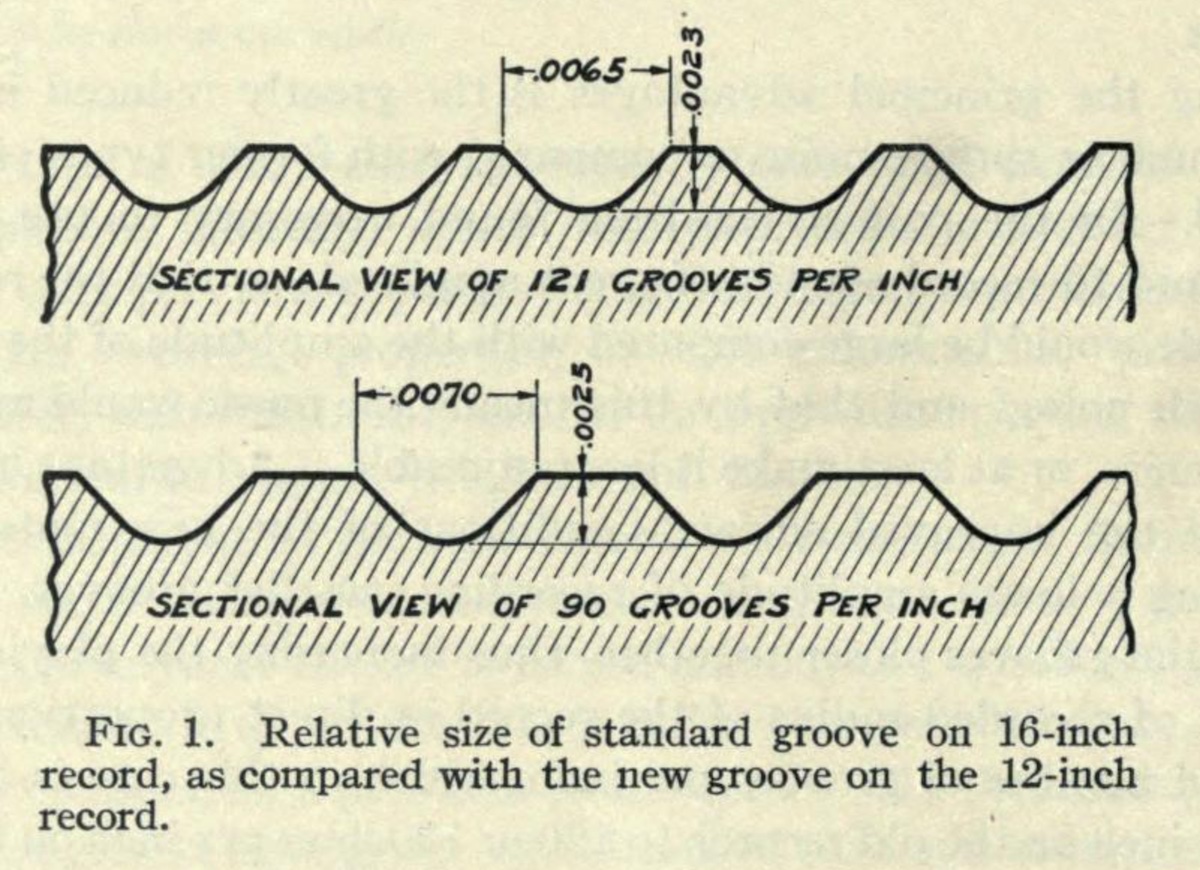
source: “Victrolac Motion Picture Records”, Journal of the Society of Motion Picture Engineers, April 1932, p.454.
Victrolac 12インチレコードと通常の16インチレコードとの比較
音溝の曲率は従来のまま、従来より浅く狭くカットすることで、記録可能な音レベルは下がりますが、盤の材質がスムーズになったことで、S/N比があがっているので、結果今まで以上にS/N比を稼いたまま長時間録音が可能になった、という理屈になります。
By keeping the curvature in the bottom of the groove is the same, but cutting the groove is a little narrower and shallower, maximum recorded sound level gets lower; but the record surface being smoother, resulting better signal-to-noise ratio. As a result, long playing is possible while keeping the better S/N ratio.
It is well known that the response characteristic, or the ability to reproduce from the record certain frequencies, is directly associated with both the linear speed and the width of the groove. In other words, the higher the linear speed or the narrower the groove, the greater is the possibility of reproducing from the record the higher frequencies. The narrowing of the groove on the new record accounts for the fact that smaller center diameters down to 5½ inches may be used in the new records, while still maintaining a frequency response characteristic equal or superior to that obtained from the 16-inch records with the larger center diameter.
Another advantage of the material used for these records lies in its strength and flexibility. On account of these features it has been found possible to produce a 12-inch record for motion picture work weighing approximately 4 ounces, as compared with 24 ounces for the 16-inch record. In addition to the reduction in weight, the record is practically unbreakable.
These two features make possible a very considerable saving for the producer or distributor in shipping the records. Extremely careful and cumbersome packing of records is no longer necessary, and ship- ments may be made by mail or express without other protection than a couple of sheets of corrugated board on either side of the record so as to prevent damaging the record surface by allowing it to come into contact with other packages. The new record is approximately 0.040 inch thick.
再生特性(または記録された特性から再生する能力)は、記録溝の線速度と、溝の幅に直接関係していることがよく知られている。別の言い方をすると、線速度が上がれば上がるほど、または音溝が狭くなれば狭くなるほど、レコード再生時により高域を再生できる可能性が高まるということである。今回の新しいレコードにおいて、音溝の幅を狭くすることで、中心径を5 1/2インチまで小さくしても、中心径のより大きい16インチレコードと同等の周波数特性が得られることになる。
新しいレコードに使われている材質のもうひとつの利点は、その強度と柔軟性にある。これらの特徴により、16インチ盤1枚が24オンス(約680g)であるのに比較して、この新しい12インチレコードでは1枚約4オンス(約113g)に抑えることが可能となる。軽量化に加え、この新型レコードは割れにくいという特徴もある。
これら2つの特徴により、生産者および販売者がレコードを配送する際、大幅な節約が可能となる。レコード梱包時の非常に慎重で面倒な作業は必要ではなくなり、記録面を傷つけないよう段ボールを重ねるなど保護する以外は、通常の郵便や速達便で出荷が可能となる。この新型レコードの厚みは約0.04インチ(約1ミリ)である。
“Victrolac Motion Picture Records”, Journal of the Society of Motion Picture Engineers, April 1932, p.455重いピックアップと鉄針で再生するシェラック盤では、鉄針による盤の痛みを抑えるために、抗摩耗充填材(研磨剤、抗摩耗剤、abrasive filler)が配合されていました。だから、鉄針は再生のたびにみるみる削れていって、頻繁な針の交換が必要でした。そして、盤面はどうしてもザラザラしてしまい、サーフェスノイズが大きかったというわけです。
In order to cope with heavy pickups and steel needles, abrasive fillers were mixed into shellac compounds for 78rpm records. This will wear down the steel needle quickly, resulting in the need for frequent changes of needles. Also, because of the abrasive filler, record surface is not smooth enough to keep surface noise quiet.
それに対し、Victrolac という新しい素材では、抗摩耗剤を含めないことで、サーフェスノイズを大幅に減らすことができるようになりました。また、鉄針の先にクロムをつけたり鉄針をクロムコーティングすることにより、盤も針も痛まずに再生が可能となります。
But for Victrolac records, none of the hard, highly abrasive fillers were used, thus it contributed to reduce the surface noise effectively. What’s more, by using a steel needle having a chromium tip (or chromium-coated steel needle) for reproduction, records wear would go very slowly, and needle’s wear also would go slowly as well.
Another but possibly less important advantage lies in the decrease of abrasion of the needle. An ordinary full-tone steel needle will show much less wear after playing one of the new records than after an equivalent amount of playing one of the old. (Fig. 2.)
もうひとつの利点(そこまで重要ではないかもしれないが)は、針の摩耗が減少することである。通常の鉄針で新しい(Victrolac)盤を再生した場合、古い(シェラック)盤を再生する時よりもはるかに針の摩耗が少なくなる(Fig.2 を参照)。
“Victrolac Motion Picture Records”, Journal of the Society of Motion Picture Engineers, April 1932, p.455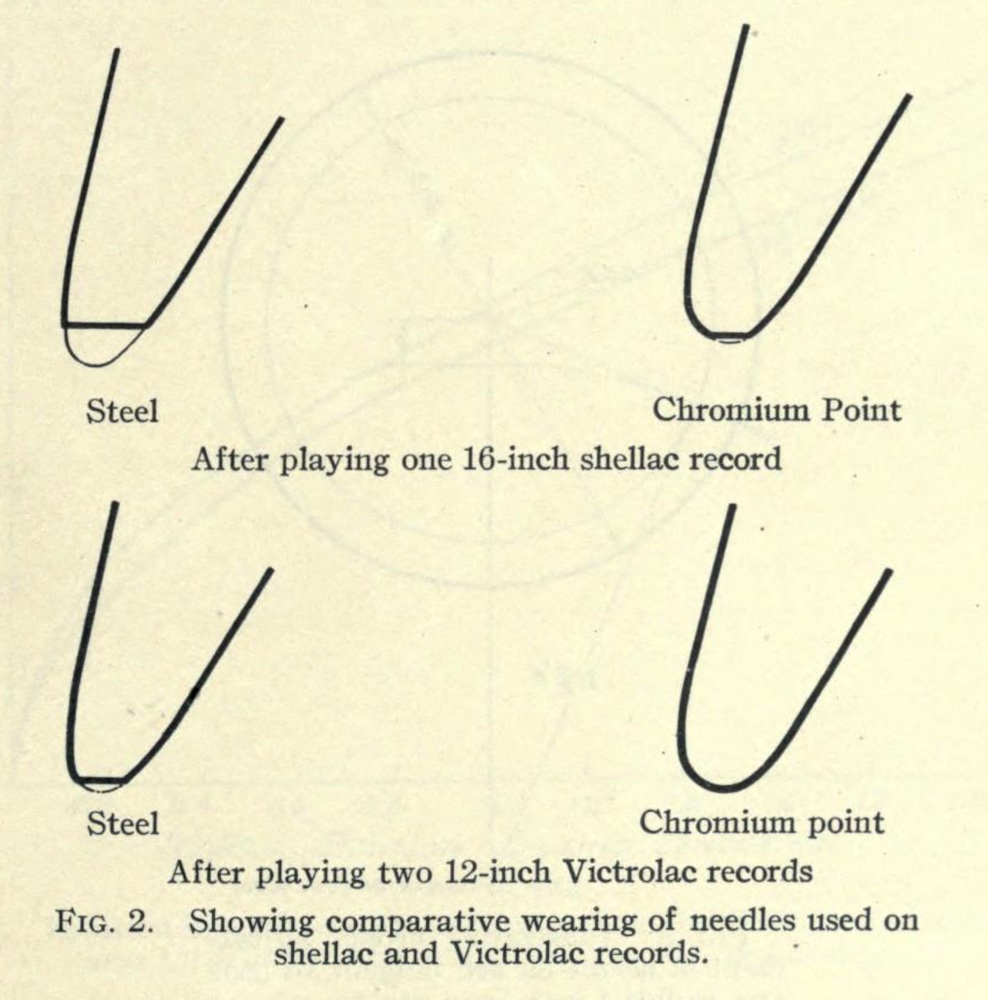
source: “Victrolac Motion Picture Records”, Journal of the Society of Motion Picture Engineers, April 1932, p.455.
シェラック盤を再生した時と Victrolac 盤を再生した時の針の摩耗具合の比較
その他、再生時のピックアップの針圧は3オンス(約85g)にまで軽くしても十分な再生が可能であり、実際の映画館で使用するには25回再生ごとにクロム針を交換するだけで良い、これにより通常の映画館では映写機ごとに1日に1回の針交換で済むことになる、などと書かれています。
This paper also notes that “since the amplitude of recording of the new records is considerably reduced, there is no longer the need for so great a weight to insure tracking, and 3 ounces have been found ample”, and “when used under a 3-ounce load this needle (a full-tone steep needle having a chromium tip) will successfully play at least twenty-five of these 12-inch records”, then “twenty-four records would be played on each projector each day, requiring a change of needle only once a day per projector.”
映画館用では専用の軽量ピックアップが使われていたと考えられますが、市販用の Program Transcription では、従来同様の重い針圧のピックアップが使われていたため、盤がどんどん磨耗してしまった、ということなのでしょうね。
Although light pickups were used at Motion Picture theaters specially for Victrolac soundtrack records, Program Transcription records (for consumer market) were played with conventional, heavier pickups (5 ounces or more of tracking force), so the records were worn out very easily.
いろいろ調べているときに、とあるMLアーカイブで次のような書き込みを見つけました。
10インチの Program Transcription 盤は、私が確認した限り、通常のシェラック盤だった。一方12インチは Victrolac 盤で、これは US特許 2,130,239 でカバーされている。「ヴィンソル」というのは、ダイオウマツ(大王松)の切り株を裁断して抽出された(アビエチン酸から作られた)プラスチックで、対して PVC(我々がヴァイナルと呼ぶもの)は、57%の塩素と43%の石油から作られている。
[Phono-L]Victor long playing records, Dan Kj, Sun Dec 24 13:11:35 2006で、読んでみました、US特許 2,130,239「Phonograph Record」を。
どうやら、Victrolac は、天然樹脂(シェラック)と合成樹脂(ヴィンソル)、顔料、フィラー、を混合した素材から作られたレコード、ということのようです。
While web-searching this and that, I found this post at the Phono-L mailing list archive:
All 10″ Program Transcriptions which I have seen were/are made of standard shellac-formula stuff; the 12″ of Victrolac, which was covered in US patent number 2130239. “Vinsol” is the plastic (made of oxidized abietic acid), extracted from shredded longleaf yellow pine stumps, while PVC (which we call vinyl) is 57% chlorine and 43% petroleum.
[Phono-L]Victor long playing records, Dan Kj, Sun Dec 24 13:11:35 2006So I read the US patent 2,130,239 “Phonograph Record”.
And I learned that the Victrolac is made of a compound of natural resin (shellac), synthetic resin (vinsol), filler and pigment.
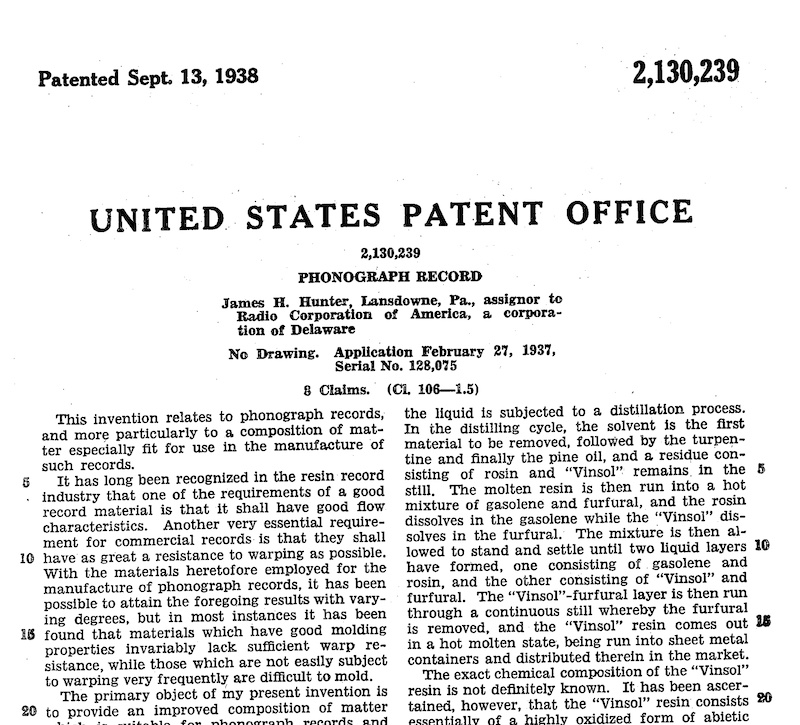
4.3 Birth of “Electrical Transcription” Records / トランスクリプション盤の誕生
さて、ここからが本題です。民生用の Program Transcription 盤ではなく、ラジオ放送局向けに制作された トランスクリプション盤 (Electrical Transcription records) です。
Okay, finally the main part of this Part 4 of my entire article – we are going to learn about the Electrical Transcription records for radio broadcast stations (not to be confused with Program Transcription records for consumer market).
そもそもトランスクリプション盤とは何か、なぜ生まれたのか、についておさらいしておきましょう。
To start with, we are going to relearn about what the electrical transcription record is, why it was born.
1920年代のラジオ局では、音楽やラジオ劇などは生中継、生収録で放送されていましたが、東海岸向けと西海岸向けで数時間後に同じ演奏をしなければいけない煩雑さであったり、同じ内容を繰り返し放送できなかったり、演奏のミスもそのまま放送されてしまったりするため、記録メディアの活用が求められていました。
In the 1920s, radio stations played music and radio dramas “live on-the-spot”. It required to play same performance after few hours – one for Eastern Standard Time, then for Western Standard Time. Also, live broadcasting was not suited for repetitive programs with the same content, and performers were always facing with the pressure of live recordings.
音楽でいうと、通常の市販の78回転盤をかけることはできますが、サーフェスノイズの問題もあり、また片面が3〜5分のため、長時間の放送には向いていませんでした。
As for music, radio stations could play commercial 78rpm records, but they had innevitable surface noise; only three to five minutes of playing time each side was not enough for long broadcasting programs.
当時はまた、ラジオ局はレコードレーベルの敵でもありました。今ではあまり考えられない感覚かも知れませんが、「タダで聴けるラジオで、レコード音源を流されると、レコードの売り上げに悪い影響がある」と考えられていました。実際、レコードの売り上げはラジオ(やトーキー映画など)、更には大恐慌によって壊滅的に落ち込んでいました。当時のレコードのレーベルを見るとよく「NOT LICENSED FOR RADIO BROADCAST」と書かれているのはそのためです。
What’s more, radio stations are competitors in business for record labels and phonograph makers. It might be unthinkable in this 21st century, but phonograph industry in the early 1920s regarded “phonograph broadcasting in radio are harmful for our industry – resulting in poor record sales – listeners won’t buy records because they enjoy the music at no cost via radio broadcasting.” This is why many records have “NOT LICENSED FOR RADIO BROADCAST” printed on the labels.
The Federal Radio Commission recently objected to constant use of records for broadcasting, adding:
“For example, the public in large cities can easily purchase and use phonograph records of the ordinary commercial type. A station which devotes the main portion of its hours of operation to broadcasting such phonograph records is not giving the public anything which it cannot readily have without such a station.’
連邦無線委員会は先日、ラジオ放送時に常時レコードを使用するすることに意義を唱えた:
”例えば、大都市の公衆は、市販用のレコードを容易に購入し視聴可能である。放送時間の大部分がレコード再生にあてられているような放送局は、視聴者に対して、その放送局でなければ聴けないようなコンテンツを提供しているとは言えない。”
Phonograph Programs Asset to WBZ-WBZA, Radio World, October 27, 1928, p.11ラジオでレコード音源をそのまま放送することについて、1930〜1940年代当時は多くの訴訟が行われたりしていました(この辺の話を深掘りすると長くなるので本稿では割愛します)。一方、それらへの対策として、また、ラジオ放送局への利便性提供(と新たなビジネス市場)として、ラジオ放送局向けの特別なレコードを製造し流通・販売させることが考えられていきました。
There had been many lawsuits going on in 1930s-1940s, about radio stations airing commercial disc records (this episode is too complex and long to include the series of my entire articles). On the other hand, specially recorded discs for radio stations were starting to spread, in order to avoid conflicts; and to provide convenience for radio stations; what’s more, to cultivate a new business market.
As early as 1927, however, advertising executive Edgar H. Felix was advocating the syndication of specially produced sound recordings (as opposed to ordinary commercial releases) as a way to offer affordable, consistently high-quality radio programming.
しかし、1927年の時点で早くも、広告代理店の Edgar H. Felix は、通常の市販用レコードではなく、手頃な価格かつ一貫した高音質のラジオ番組を提供する方法として、特別に制作された音源のシンジケート構築を提唱していたのである。
Recording the 'Thirties, Allan Sutton, 2011, p.35先ほどの連邦無線委員会 (Federal Radio Commission) も、そのようなアイデアを支持していました。
Federal Radio Commision also supported such idea of special phonograph records for broadcasters.
It may also be that the development of special phonograph records will take such a form that the result can be made available by broadcasting only and not available to the public commercially, into consideration.
The commission cannot close its eyes to the fact that the real purpose of the use of phonograph recordings in most communities is to provide a cheaper method of advertising for advertisers who are thereby saved the expensive of providing original programming.
また、(ラジオ放送局向けの)特別なレコードの開発は、ラジオ放送でのみ利用可能とし、一般向け市場では入手できないようにする、ということを考慮した形になるであろう。
多くの地域で放送時に通常のレコードを使用する本当の目的が、オリジナル番組を提供する費用を節約したい広告主に、より安い広告方法を提供することである、という事実に対し、当委員会は目をつぶることはできない。
Recording the 'Thirties, Allan Sutton, 2011, p.36トランスクリプション盤 とは、そんなラジオ局が活用した、あらかじめ一連の音楽やドラマなどを収録しておいたレコードのことです。市販のレコードをそのままラジオ放送できないという事情、また、放送中の生演奏ではなくあらかじめ録音された演奏音源を放送するメリット、などから、ラジオ放送専用に用意した音源をラジオ局向けのみに販売されるレコードが、トランスクリプション盤ということになります。
Electrical Transcription was such a special long playing record containing prerecorded music and drama, distributed and sold for radio stations. Such records contained the music performed especially for broadcasting (not copies of commercial disc records), as well as previously recorded radio dramas. This allowed flexibility and convenience for radio stations.
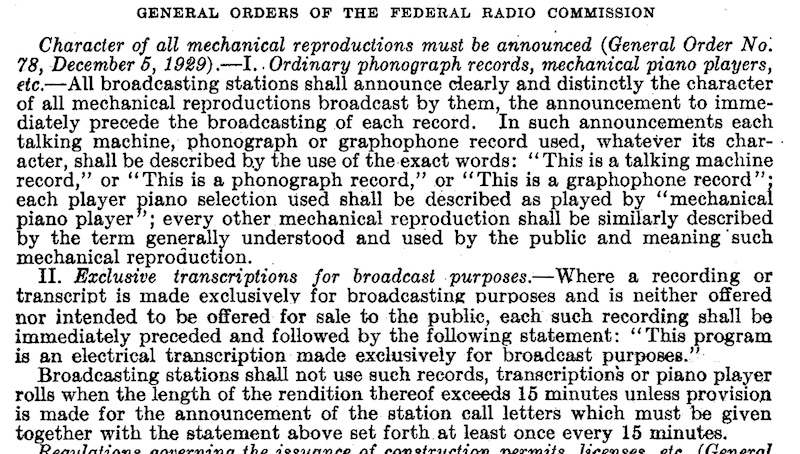
source: “Radio Service Bulletin, Washington, December 31, 1929 – No.153”
ラジオ放送時には、通常のレコードをかける際には「これはフォノグラフレコードです」などとアナウンスすること、トランスクリプション盤の場合は「この番組は放送目的専用のトランスクリプション盤です」と15分おきにアナウンスすることが定められた文書
The 1929 General Order to define all broadcast stations shall announce clearly and distinctly … “This program is an electrical transcription made exlusively for broadcast purposes.” … at least once every 15 minutes
1929年に誕生した World Broadcasting System 社の World Program Services(当初は78回転レコード、のちに33 1/3回転)などを皮切りに、1930年代に入るとトランスクリプション盤製造流通レーベルが次々と誕生しました。全米のラジオ局でシンジケートが出来ていき、系列ラジオ局に同じ内容のトランスクリプション盤が配布・販売され、それぞれで放送されていました。
One of such recording services for radio industry was the World Program Services label of World Broadcasting System, Inc., founded in 1929. In the 1930s, many other recording services surfaced, and began distributing recorded program discs to a chain of stations. This was the early syndicated radio production.
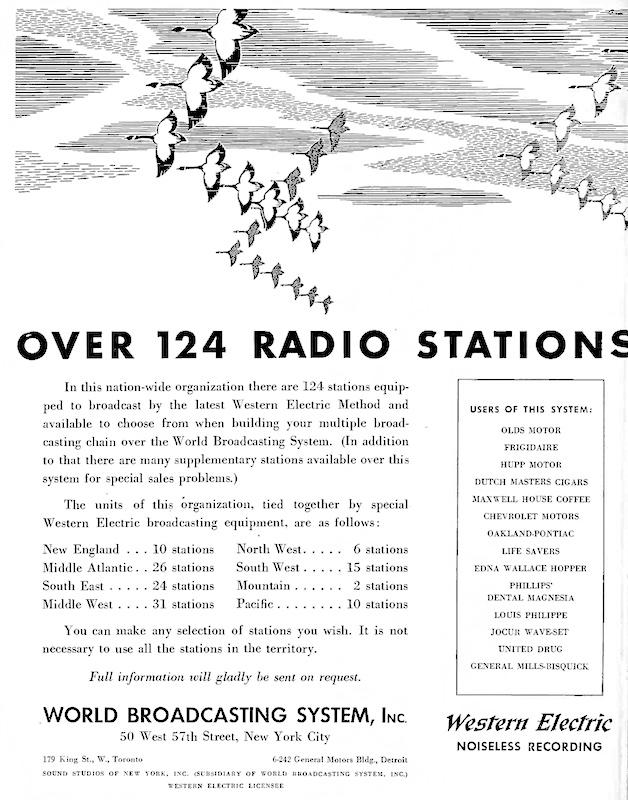
source: World Broadcasting System Ad, Broadcasting, May 15, 1932, p.6
Broadcasting 誌1932年5月15日号に掲載の、WBS 社広告
“Western Electric Noiseless Recording” の表記が確認できます
ほどなく、回転数は 33 1/3回転で、溝の幅(大きさ)は通常の78回転盤より少し狭く、盤のサイズは16インチと大きく(12インチや10インチもまれに存在)、片面で15分以上を収録可能なメディアに統一されていきました。通常の78回転盤は3mil針が標準でしたが、トランスクリプションでは2mil針が使われました。
It was not long before the disc format somehow settled down to 33 1/3rpm, coarse groove (but a bit narrower than that of regular 78rpm commercial discs), 16-inch (some 12-inch and 10-inch existed), fifteen minutes or more on one side. Regular 78rpm used 3 mil stylus, while Electrical Transcription discs used 2 mil stylus for playback.
このトランスクリプション盤は、上述したトーキー映画向けのヴァイタフォン (Vitaphone) や、民生用長時間レコードの Program Transcription の技術と関連があり、かつ延長線上にあります(正確には、Program Transcription やトランスクリプション盤が、ヴァイタフォンやの延長線上、ですが)。
The Electrical Transcription shares the fundamental technologies with Vitaphone (for talkie motion pictures) and Program Transcription records (longer playing records for consumer market), and is seen an extension of them (more precisely, Program Transcription is the extension of Electrical Transcription, which is the extension of the Vitaphone).
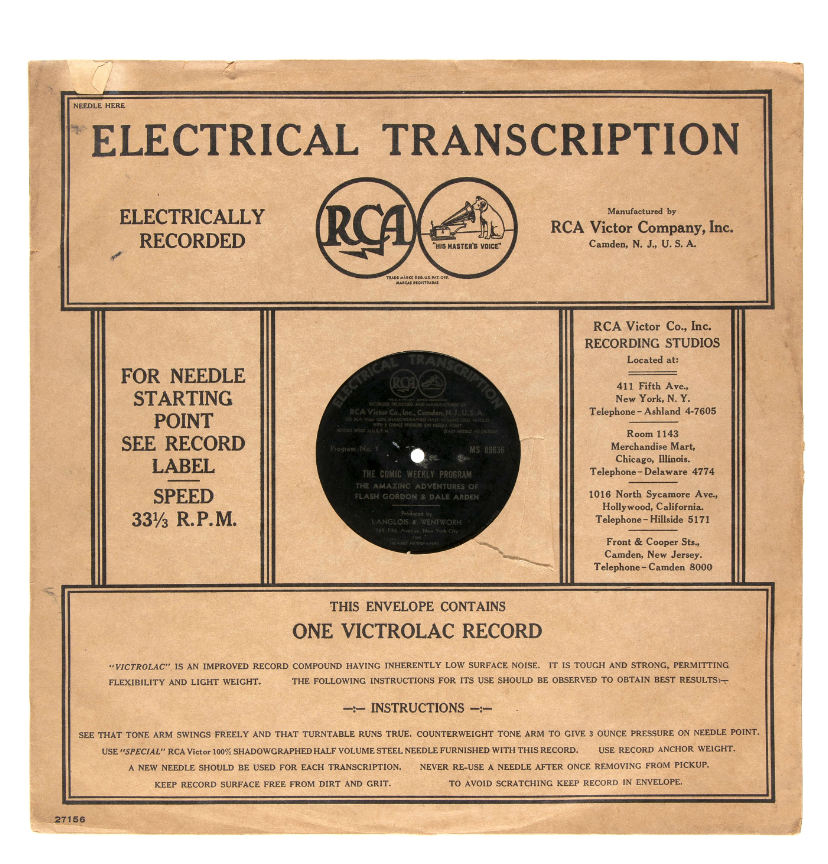
source: “THE AMAZING ADVENTURES OF FLASH GORDON & DALE ARDEN” 1935 LOT OF FIVE RADIO TRANSCRIPTION DISCS..
RCA Victor の放送局向け Electrical Transcription の例。16インチ Victrolac 製、33 1/3回転、横振動記録。
スリーブ下部には Victrolac の説明もあり、3オンス (約85g) の針圧で再生すること、RCA Victor 製の専用鉄針を使うこと、など指示があります。
Example of RCA Victor’s Electrical Transcription disc for broadcast stations; the sleeve says “Counterweight tone arm to give 3 ounce pressure on needle point” and “Use “Special” RCA Victor 100% Shadowgraphed Half Volume Steel Needle furnished with this record”.
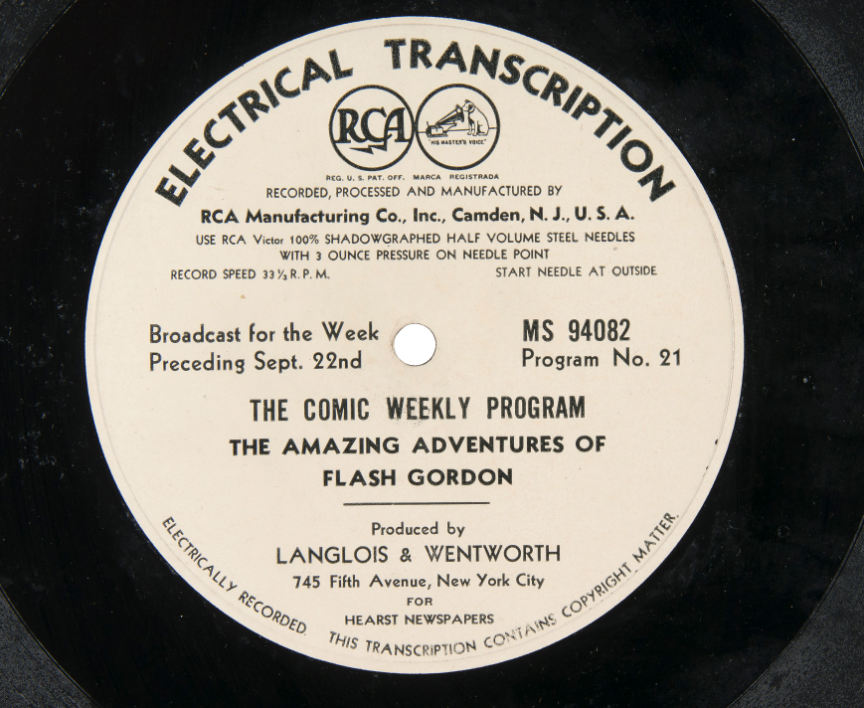
source: “THE AMAZING ADVENTURES OF FLASH GORDON & DALE ARDEN” 1935 LOT OF FIVE RADIO TRANSCRIPTION DISCS..
RCA Victor Electrical Transcription (Victrolac) のレーベルの例
レーベル面には “Start Needle at Outside” とあります。
Example of RCA Victor’s Electrical Transcription label; the label says “Start Needle at Outside”.
トーキー映画業界において、sound-on-disc 方式(映像はフィルムで、音声はフィルムと同期したディスクに記録)から、sound-on-film 方式(映像も音声もフィルム上に記録)に変わっていったことで、ヴァイタフォンの技術がラジオ放送用ディスクに転用されるようになったのです。
In the talking motion picture industry, “sound-on-disc” technology (recorded discs synchronized with films, like Vitaphone) was gradually driven out by “sound-on-film” technology (both motion picture and sound recorded on films). As a result, Vitaphone technology was ceded to Electrical Transcription discs for radio industry.
The 78-rpm disc format had the disadvantages of poor sound quality and short playing time. The Western Electric system of 16-inch discs revolving at 33⅓ rpm solved both these problems. When sound on film began to replace discs in film studios, many of the discarded disc recorders were picked up by transcription services eager to meet radio’s voracious demand for recorded programs.
78回転のディスクフォーマットには2つの欠点があった。貧弱な再生音質と短い再生時間である。Western Electric の開発した16インチ、33 1/3回転のシステムが両者を解決した。映像スタジオにおいて、ディスク録音がフィルム録音に置き換わっていったことにより、不要となったそれらのディスク録音機がトランスクリプション盤製造に活用され、録音済み番組を必要とするラジオ局の貪欲な要求に応えることとなった。
America on Record: A History of Recorded Sound, 2nd Edition, Andre Millard, 2005, p.173上記の件について、録音業界と映画業界の両方の歴史を調べ尽くされた Nick さんから、「映画業界ですぐにディスク録音が不要となったわけではない」とコメントをいただきました。
About the part “…many of the discarded recorders were picked up by transcription services…”, Nick Burgh (who did extensive research both on music recording history and motion picture sound history) kindly sent me comments.
注意が必要なのは、光学録音(サウンド・オン・フィルム)方式が Vitaphone のようなサウンドトラックディスクを置き換えたのちも、メジャーレーベルの録音スタジオが1日にカッティングするより多くのディスクを映像スタジオでカッティングされていた、という事実だ。(中略)フィルム映像スタジオはその後数十年間ディスク録音を大量に行っていた。
Be aware that even after optical sound overtook soundtrack discs (like Vitaphone), the film studios were still possibly cutting more discs in a day than the major music studios. … Film studios still did LOTS of disc recording for decades.
その目的は2つあった。
(1) 光学録音方式の映像・音声同時記録では、撮影直後のネガを再生することができないので、撮影中にディスク録音も同時に行っておき、それを使って撮影テイクの音声をチェックしていた。1940年末にテープ録音が導入されるまでずっと行われていた方法だ。
(2) 映像収録中に音楽の演奏や歌唱がある際には、音源をディスク再生してリップシンク式で収録されていた。撮影スタジオでは、収録中に必要なリップシンク用の音源を 33 1/3回転のディスクに前もって手元でカッティングしておく必要があった。
They used disc recording for two purposes:
(1) It is not possible to listen back to a take on optical negative so they would record on discs simultaneously so they could listen to the take. This did not fully go away until magnetic film started to be used in the late 1940s.
(2) Anytime there is an onscreen music performance, this is done to a playback disc (lip syncing). The film studios needed to be able to cut synchronous 33.3rpm discs to be played back on the set to lip sync to.
Vitaphone や他のサウンドトラックディスク用のレースがこの2つの目的のために使用された。1920年代に製造された Vitaphone レースの中には、モーターやカッターヘッドをアップグレードしつつ、なんと1960年代まで使われていたものもある。映画館でディスク音源が使われなくなったことが、サウンド・オン・ディスク方式が廃れた主要因だ。
The same lathes used for Vitaphone or other soundtrack discs were used for both of these purposes. Some of the 1920s Vitaphone lathes were still in use at the studios (with motor and head upgrades) into the 1960s. The main thing that became obsolete was just the disc playback technology in the theaters.
Victrolac は (中略) 上記の (2) の使用目的に適していた。だから Society of Motion Picture Engineers の論文誌に(“Victrolac Motion Picture Records” の論文が)掲載された、ということだ。(中略)しかし、数年後にラッカー盤が登場すると、プレスを必要とせず録音後すぐ再生でき、また安価なので、撮影スタジオは Victrolac からラッカー盤に移っていった。
Victrolac (…) would be for use (2). This is the main reason the paper (“Victrolac Motion Picture Records”) was in the SMPE Journal. (…) However, once lacquer discs came out a couple years later, the studios just used lacquer since it was a one-step process and less expensive.
quoted (and edited a bit) from the email written by Nicholas Bergh to me on Oct. 17, 2022Nick さん、膨大な知見と資料に基づく貴重なコメント、いつもありがとうございます。
Thank you again for your invaluable comment backed by comrehensive knowledge and documentation, Nick-san!
民生用(市販用)レコードでは、再生機器が手回しアコースティック蓄音機から電蓄までバラバラだったのに比べると、映画業界やラジオ業界はプロフェッショナル市場であり、再生環境も厳密に規定されかつより高品質なものが求められていたため、更なる技術革新が求められる土壌がありました。
Playback equipments for commercial 78rpm records varied from hand-wound gramophone players to electric gramophone players, while motion picture industry and radio industry were “professional”: they needed more precise, higher-quality, strictly controlled playback equipments. This led the recording technology in the 1930s made further improvements and technological innovation.
以下、今回の Pt.4 と次回の Pt.5 で、そのあたりの歴史を探っていきます。
In the following part of this Pt.4 (and the next Pt.5 of this series), I am going to walk through the history of Electrical Transcription records.
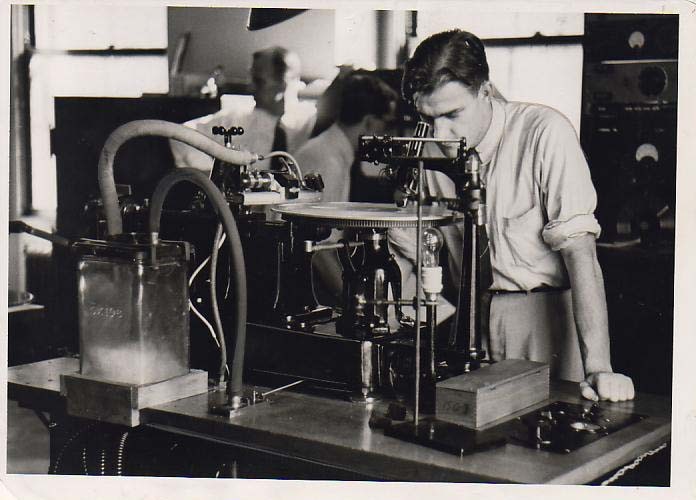
source: “A Brief History of Recording to ca. 1950”, Roger Beardsley and Daniel Leech-Wilkinson, AHRC Research Centre for the History and Analysis of Recorded Music
16インチトランスクリプションディスクのカッティングレース。ラバーラインレコーダのように見えます。
Cutting lathe of 16-inch transcription disc – the system looks like “rubber-line”?
4.4 Bell Labs / WE’s “Hill-and-dale” Transcription / ベル研/WEの縦振動トランスクリプション
トランスクリプション盤の技術革新の先陣を切ったのは、またしても Bell Labs / Western Electric でした。当時の市販用電気録音レコード(78回転盤)や Vitaphone(トーキー映画用ディスク音源)を超えて、より高音質な記録再生を目指して開発されたものでした。
The first innovation was brought, once again, by Bell Labs / Western Electric. The innovative team tried to develop higher-fidelity recording and reproduction than regular electrically-recorded 78rpms and Vitaphone discs.
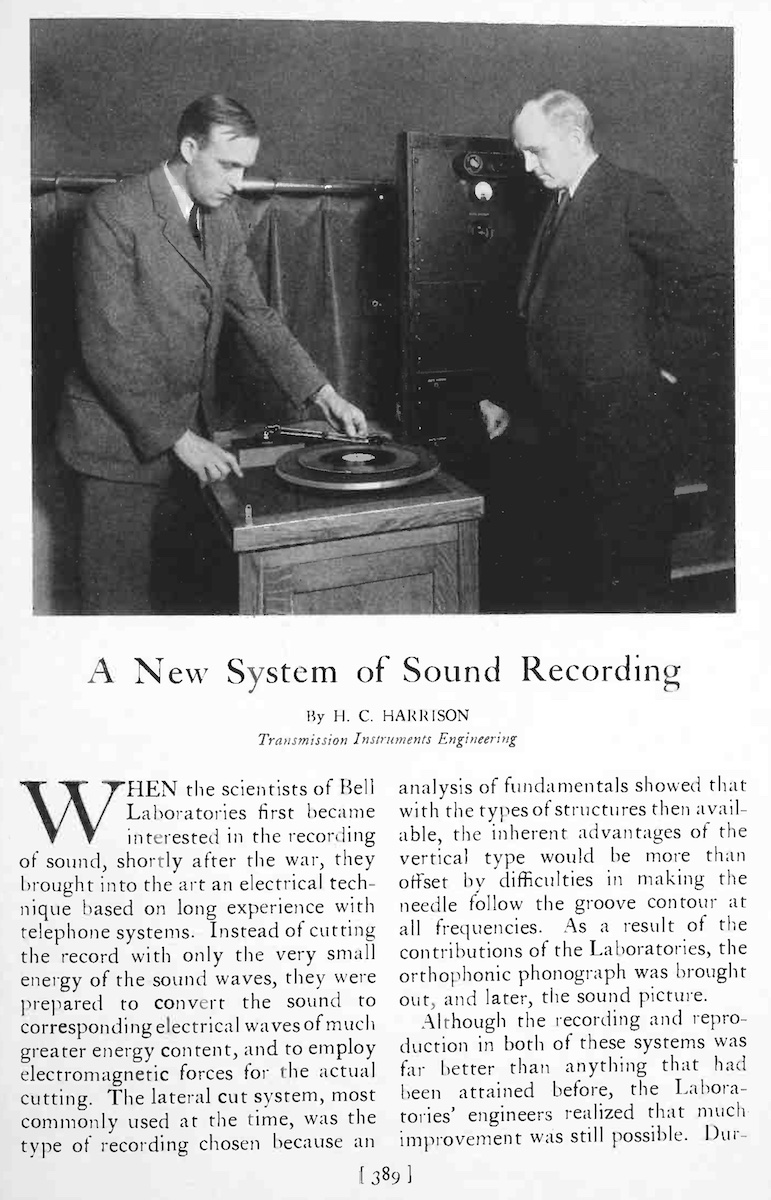
source: “A New System of Sound Recording”, by H.C. Harrison, Bell Laboratories Record, Vol.10, No. 11, July 1932, p.389.
電気録音発明者の1人、Harrison 氏による、Bell Labs 縦振動トランスクリプション盤の解説記事
Vitaphone のように抗摩耗剤を減らした硬質シェラック盤でもなく、Program Transcription 盤のような Victrolac 盤でもなく、アセチルセルロース(セルロースアセテート)盤にプレスされました。数年後(1930年代中盤?)には、ヴィニライト盤(Victrolac? それとも Union Carbide and Carbon の Vinylite?)に変更されたそうです。
This vertical transcription disc is not made of hard shellac (with less abrasive filler), not made of Victrolac compound, but made of cellulose acetate. A few years later (maybe in the mid-1930s?), cellulose acetate was replaced with vinylite (Victrolac? Union Carbide and Carbon’s Vinylite?).
1931年秋に学会の研究会で口頭発表された研究が、Journal of the Society of Motion Picture Engineers 論文誌1932年2月号に “Vertical Sound Records: Recent Fundamental Advances in Mechanical Recorders on Wax” として掲載されています。
H.A. Frederick of Bell Telephone Laboratories made a presentation in the Fall of 1931 at the meeting at Swampscott, MA, then the paper was published on the Journal of the Society of Motion Picture Engineers, Feb. 1932, entitled “Vertical Sound Records: Recent Fundamental Advances in Mechanical Recorders on Wax”.

source: Journal of the Society of Motion Picture Engineers, February 1932, p.141.
Frederick 氏の縦振動レコード論文のアブストラクト
Abstract section of H.A. Frederick’s Vertical record paper.
まず、なんといっても驚かされるのは、エジソンが発明し実用化していた 縦振動 記録方式が採用されていることです。
Surprisingly enough, they adopted vertical recording that was initially invented and practicalized by Thomas Edison, but was not a main figure of disc recording anymore in the electrical recording era.
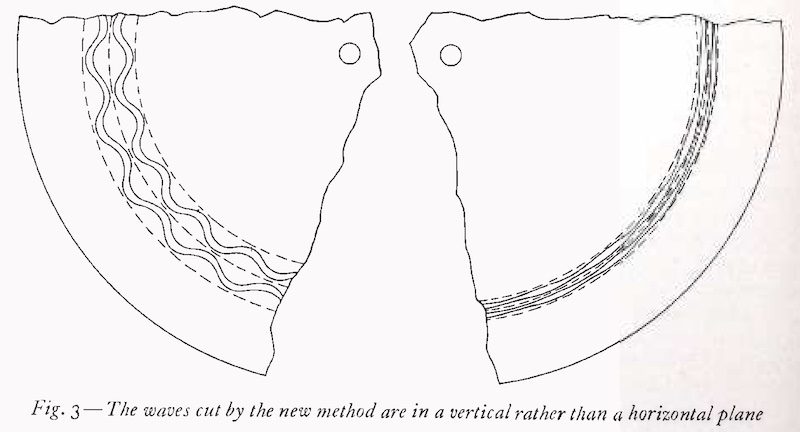
source: “A New System of Sound Recording”, by H.C. Harrison, Bell Laboratories Record, Vol.10, No. 11, July 1932, p.392.
横振動記録と縦振動記録の比較。音溝の振幅が大きくなっても、縦振動の場合高密度で記録可能であることを説明する図版
comparison of lateral / vertical cuts; showing the vertical cut with high density
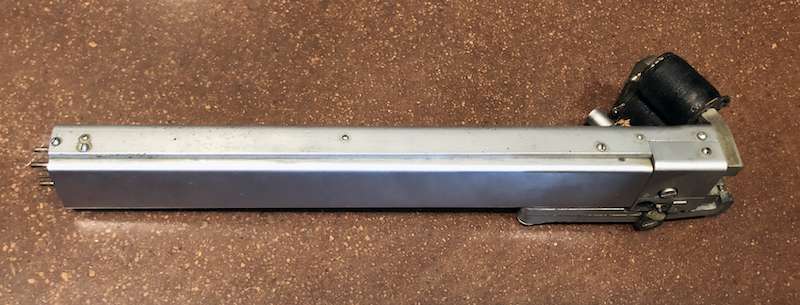
Picture of an improved WE d-spec vertical cutting head, probably from 1934 or 1935
1934〜35年頃に製造された、Western Electric 改良版Dスペックの縦振動記録用カッターヘッドの実物 (Nicholas Bergh さん提供)
photo courtesy of Nicholas Bergh.
ベル研は1920年代末から数年間をかけて、「盤に音を記録するとは」「再生するとは」「そもそも演奏や発話における音とは」について再度仔細に調査研究を行いました。
Since late 1920s, Bell Labs had spent a few years of very detailed researches of “what makes disc recording (engraving) improve?”, “what makes disc reproduction improve?” and “investigation of the energy distribution of the sounds to be recorded – speech, music and other sounds”.
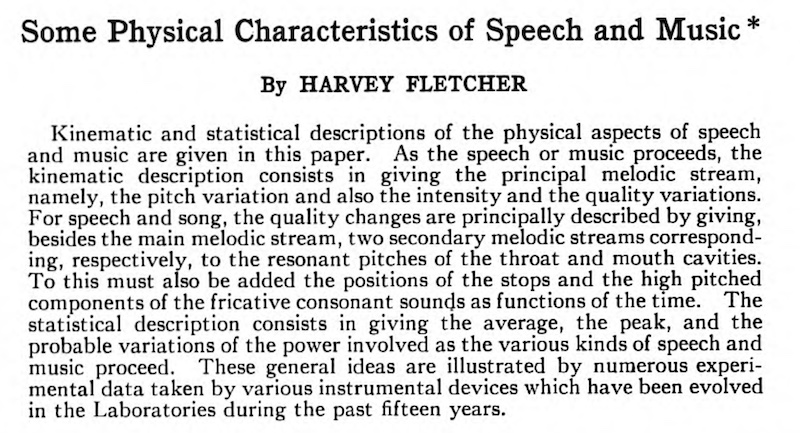
source: “Some Physical Characteristics of Speech and Music”, Harvey Fletcher, The Bell Technical Journal, July 1931, pp.349-373.
ベル研の1931年7月掲載論文のアブストラクト
あの著名な物理学者 Harvey Fletcher 氏の執筆
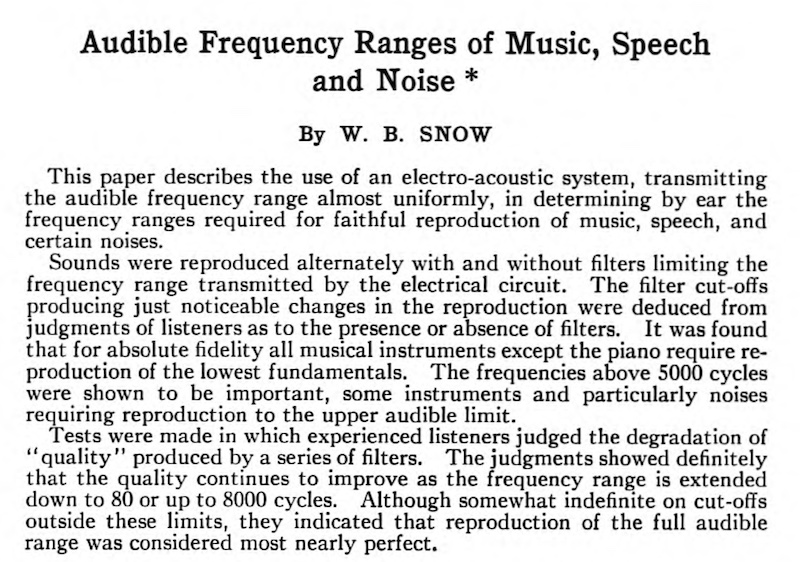
source: “Audible Frequency Ranges of Music, Speech and Noise”, W.B. Snow, The Bell Technical Journal, October 1931, pp.616-627.
ベル研の1931年10月掲載論文のアブストラクト
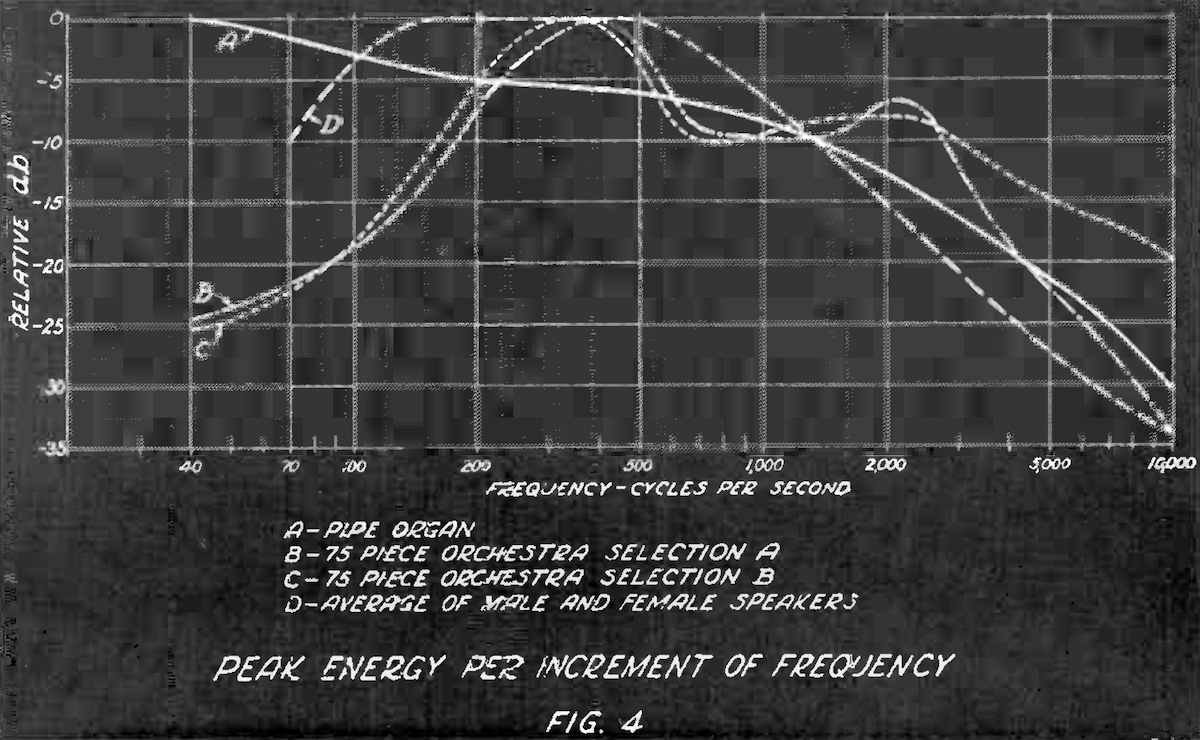
source: “Lateral Disc Recording”, RCA Broadcast News, Number 35, February 1941, p.4.
パイプオルガン、オーケストラ、男女の発声、それぞれのピークエネルギー分布をグラフにしたもの
この図自体は1940年のRCA/NBCが掲載したものだが、元々はベル研の研究に由来していると思われる
Peak Energy per Increment of Frequency: pipe organ; 75 piece orchestra selections; average of male and female speakers.
This graph is from RCA/NBC 1940 article, but this probably originated from the Bell Labs’ research.
当時の重いピックアップでは、横振動の記録・再生によるデメリットが無視できず、垂直方向に波を刻む縦振動記録再生の方が、記録密度をあげられ、再生歪を軽減できるメリットがある、という結論が導かれ、横振動によってほぼ駆逐されたはずの縦振動記録方式をあえて採用したようです。針は2.5milが使われていたとのことです。
Then they drew a conclusion that vertical recording/reproducing is superior to lateral recording/reproducing: lateral-cut records produce much distortion with heavy pickups of improper trackability, but vertical-cut records can eliminiate it; lateral-cut groove need more space to avoid overcut (contiguous grooves joining each other), but vertical-cut groove need less space and improves grooves-per-inch density.The stylus size was 2.5 mil.
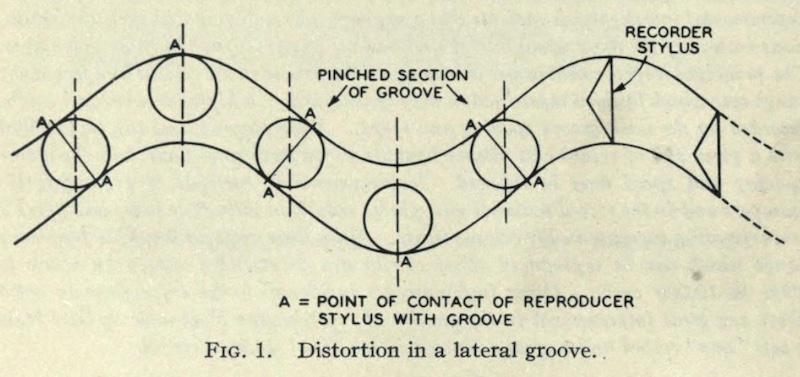
source: “Vertical Sound Records”, Journal of the Society of Motion Picture Engineers, February 1932, p.142.
横振動記録のレコード再生時に避けられない歪み(と当時のベル研が判断した根拠)。録音針は、進行方向の垂直に同じ幅をキープするが、再生針は丸いため、接点の垂直方面の幅が変わり、これが再生歪みとなって現れる。
縦振動用に開発された再生ピックアップは、MC型で、サファイア針を使用、1930年代当時としては非常に軽量な針圧で再生でき、10,000Hz 前後までの再生を可能としました。
For Bell/WE vertical disc, moving-coil pickup with sapphire stylus was developed and used, with much less tracking force than other heavy pickups in the 1930s – it enabled follwing vibrations of up to about 10,000Hz.
Because of tracking problems with lateral-cut records, a certain amount of abrasive had been incorporated into the disc to wear the heavy steel needle to an approximate fit of the groove. The abrasive made noise, hence the old reproducing systems had been designed to filter from the output frequencies above about 3,500 hertz, where “needle scratch” was especially conspicuous. Since, however, there was no such danger of poor tracking in the new system, abrasive and compensatory scratch filters were unnecessary. Moreover, the absense of abrasive eliminated the need for frequent changes of worn steel needles. The new, relatively permanent sapphire stylus, without the clamp formerly needed to grasp the changable steel needle, meant a considerable saving in weight. The moving-coil pickup was now able to follow vibrations of up to about 10,000 cycles per second. Thus the new vertical-cut system offered great improvements in frequency range.
横振動記録レコードのトラッキング問題のため、レコード盤には抗摩耗剤がある程度練り込まれており、それによって重い鉄針が音溝にフィットするようになっている。この抗摩耗剤がノイズの原因となるので、古い再生システムにはスクラッチノイズが目立つ 3,500Hz 以上をフィルターするようになっていた。しかし、新しい(縦振動の)システムでは、そのようなトラッキング問題が発生しないため、抗摩耗剤もスクラッチフィルターも不要になった。さらに、抗摩耗剤がなくなったことで、摩耗した針の頻繁な交換も不要になった。(鉄針に比べると)十分に永続的に使用可能と言ってよい、新しいサファイア針には、針を交換でき針を固定するためのクランプが不要になったので、ピックアップの重量を十分に軽減できた。結果、このMC型ピックアップは 10,000Hz 程度までの振動に追従することができるようになった。このように、新型縦振動記録システムは周波数帯域の大幅向上を果たすことができたのである。
“Stokowski and the Bell Telephone Laboratories: Collaboration in the Development of High-Fidelity Sound Reproduction”, Robert E. McGinn, 19834.4.1 Intentional Treble Pre-emphasis / 意図的な高域プリエンファシス
この新しいトランスクリプションレコードは、現代のレコードに繋がる、重要な技術を備えていました。
This new electrical transcription record by Bell Labs / Western Electric was employed with a very important technology that modern disc recording system still inperits.
それは、記録可能な周波数帯域を広げ、中高域のサーフェスノイズに打ち勝つために、史上初めて、高域の意図的なプリエンファシスを採用したことです。
It was intentional treble preemphasis for the first time in the history, to cope with mid-high surface noise and to broaden the recorded frequency as possible.
つまり、サーフェスノイズ成分が多くなる中高域において定振幅記録を行い、再生時に補正することで、サーフェスノイズの音量を下げる仕組みです。ここに至って初めて、現在の一般的なレコードにつながる、録音カーブの仕組みが登場しました。
In the recording, constant amplitude is applied at treble turnover frequency and above, then compensate the emphasis in reproduction – this will greatly reduce the surface noise. This is the very beginning of the recording/reproducing EQ system that is still used today (although the parameters are different).
… In addition, it is possible to take advantage of the fact that most sounds to be recorded contain less energy in the high frequency range than in the medium or low frequency range, and to record the higher frequencies at a level somewhat higher than normal. In reproduction these higher frequencies are then correspondingly reduced by the reproducing amplifier or circuit. It is thus found that a further reduction of about 10db. in surface noise can be obtained, the amount depending somewhat on the high frequency cut-off of the reproducer or circuit. This effect occurs chiefly between 5,000 and 10,000 cycles.
… 上述のような特徴に加えて、「録音される音は、中域や低域に比べて高域のエネルギー成分は少ない」という事実を活用し、通常よりいくらか高いレベルで高域を記録しておく手法が可能である。そして再生時には、アンプや回路によってこの増幅された高域を適切に減衰させればよい。このような方法により、再生機器や回路の高域カットオフ特性に依存はするが、サーフェスノイズをさらに10dB程度低下させることができた。この(高域増幅・補正)手法は、主に 5,000〜10,000Hz の間で効果を発揮する。
Vertical Sound Records, Journal of the Society of Motion Picture Engineers, February 1932, p.146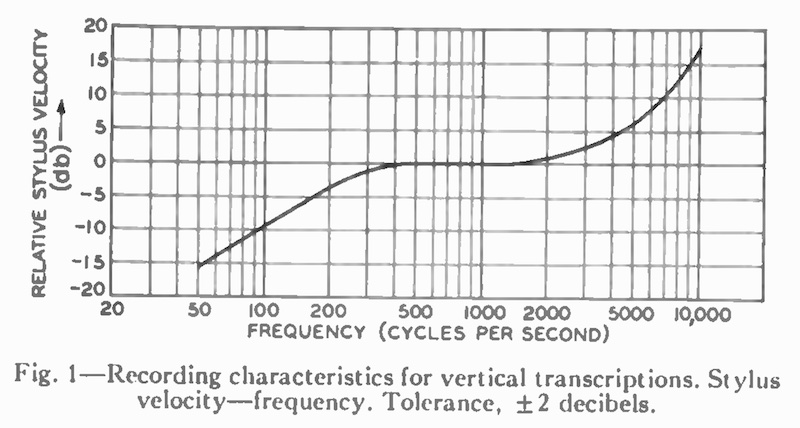
source: “Recording and Reproducing Standards”, Lynne C. Smeby, Proceeding of the I.R.E, Vol.30, No.8, August 1942, p.356.
IRE (Institute of Radio Engineers, 現在の IEEE) 論文誌に掲載された、1942年 NAB カーブ(縦振動記録用)
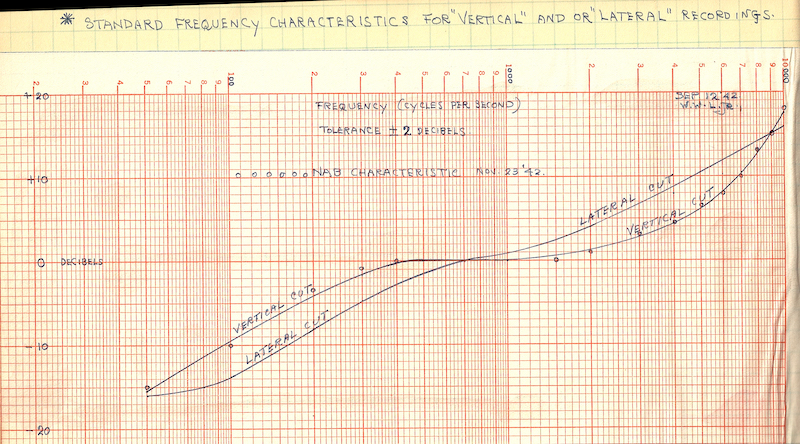
Western Electric Vertical/Lateral Recording Characteristics (1942 NAB), drawn on Nov. 23, 1942
Western Electric 社の縦振動/横振動用録音カーブ (1942 NAB vertical/lateral) をプロットした貴重なグラフ (Nicholas Bergh さん提供)
photo courtesy of Nicholas Bergh.
これにより、サーフェスノイズを抑制しつつ、より高域まで、具体的には 10,000Hz 以上の記録が可能になりました。そして、S/N比も圧倒的に改善され、通常のシェラック盤で最大30dB(記録可能な最大音量と、サーフェスノイズの最大音量の差分)であったところ、新しい盤では50dB〜55dBにまで向上しました。
With this treble pre-emphasis (for the recording) and the compensation (for playback), it can reduce annoying surface noise; also, it can record up to higher frequency (10,000Hz and up). Furthermore, signal-to-noise ratio dramatically improved: 50 to 55dB for the new records, while 30dB for regular 78rpm shellac records.
Nicholas Bergh さん(本稿 Pt.3 で紹介した、ドキュメンタリー「American Epic」でラバーラインレコーダを復刻したエンジニア)によると、この Bell Labs / Western Electric 縦振動トランスクリプションにおいて、現代のディスク録音とほぼ同等な仕組み(全く同じではない)の、録音時のイコライズ・再生時の補正を行うそれぞれ専用の回路(装置)が使われていた、とのことです。当然ながら、当時の録音用イコライザには、ハンダ付けで抵抗やコンデンサを交換したりジャンプワイヤーを接続したりすることでパラメータを微調整することはできたものの、現代の再生時におけるターンオーバーやロールオフを自在に切り替えられるようなスイッチに相当するものなどはなかったはずです。
According to Nicholas Bergh (the engineer who did magnificent work including restoring rubber-line recorder in the “American Epic” documentary, as I mentioned in the Pt.3 of my article), Bell Labs / Western Electric’s vertical recording system already had very similar recording equalizer and playback compensator as those we have today (not precisely equal, of course). Recording equalizer for the system could be fine-tuned by replacing resistors and condensers (or with soldered jump wires), but it surely didn’t have convenient switches to change parameters like the archival playback EQ units we have now.
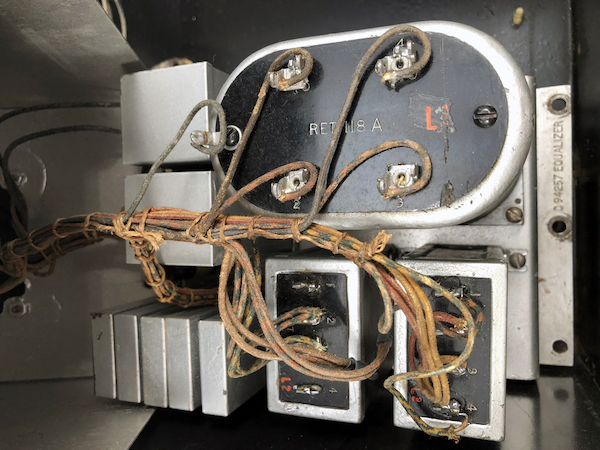
Very rare genuine WE LRC playback compensator (equalizer) from early 1930s for WE vertical transcription disc
非常に珍しく貴重な、1930年代前半製 Western Electric 社製、縦振動記録トランスクリプション盤再生用LRCフォノイコのホンモノ (Nicholas Bergh さん提供)
Photo courtesy of Nicholas Bergh.
この時点では、縦振動記録レコードにおいても、低域ターンオーバーはカッターの特性で実現し、そこに高域プリエンファシスをEQ回路で実現していました。その両者の合計が、録音カーブということになります。
At the time of 1932, recording curve for verical transcription discs was accomplished by the summation of the low frequency curve (by the cutterhead characteristic) and the high frequency preemphasis (by the recording EQ).
4.4.2 Cutterhead with electrical feedback / フィードバック回路の採用されたカッターヘッド
Bell Labs / Western Electric の技術革新はまだ続きます。
The innovation of Bell Labs / Western Electric didn’t stop there.
1932年の論文同様、1937年秋に学会の研究会で口頭発表され、Journal of the Society of Motion Picture Engineers 論文誌1938年1月号に掲載された “Recent Deveopment in Hill and Dale Recorders” では、現代のレコードにつながる、もうひとつの重要な技術について解説されています。ベル研で開発され1932年と1934年に論文発表された、モーショナルフィードバック の技術が適用され、カッターヘッドの記録特性を 30Hz〜12,000Hz でほぼフラットにしています。
Leonard Vieth and Charles F. Wiebusch of Bell Telephone Laboratories made another presentation (as an extension of the 1932 paper by H.A. Frederick) in the Fall of 1937 at the Meeting at NYC, then the paper was published on the Journal of the Society of Motion Picture Engineers, Jan. 1938, entitled “Recent Development in Hill and Dale Recorders”. In this paper, another innovative technology was presented: motional feedback technology (that was researched and developed also by the Bell Labs, published in 1932 and 1934) was used for the cutterhead, to provide the output in direct proportion to the stylus velocity – thus flat frequency (uniform) response was obtained from 30 to 12,000Hz.
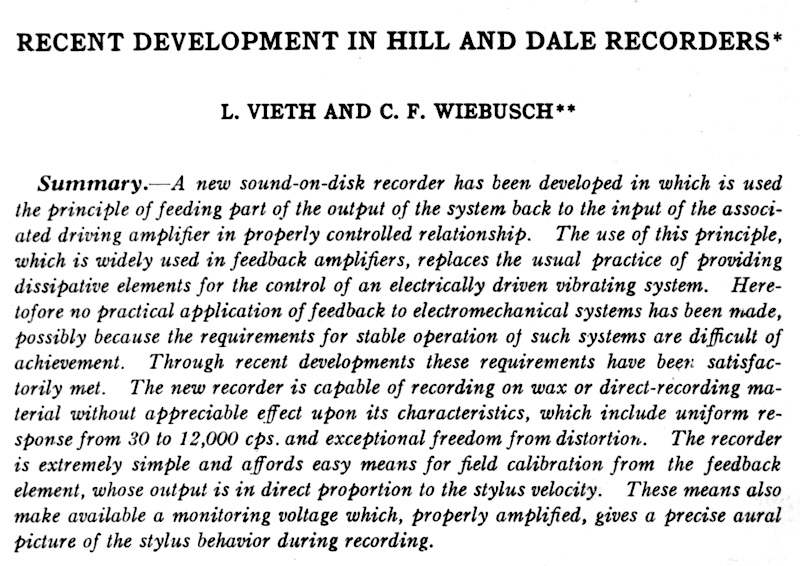
source: Journal of the Society of Motion Picture Engineers, January 1938, p.96.
Vieth 氏と Wiebusch 氏の縦振動記録装置の論文のアブストラクト
Abstract section of Vieth & Wiebusch’s “hill-and-dale” recorder paper.
それ以前は、カッターヘッドの記録特性(ターンオーバー周波数より下が定振幅、それより上が定速度)に加えて、高域プリエンファシスを行うことで、録音カーブとしていましたが、カッターヘッドのフラット特性が得られたことで、録音カーブを独立した回路として持つことができるようになったのです。これは 米国特許2161489 “Vibratory System” として登録されています。
Before this invention, recording characteristic was obtained with the cuttehead characteristic (constant amplitude below the turnover frequency, and constant velocity above the frequency), plus treble preemphasis. And now, by accomplishing the cutterhead’s uniform response being obtained, the entire recording curve became independent as a dedicated circuit. This invention was filed as the US Patent 2,161,489 “Vibratory System”.
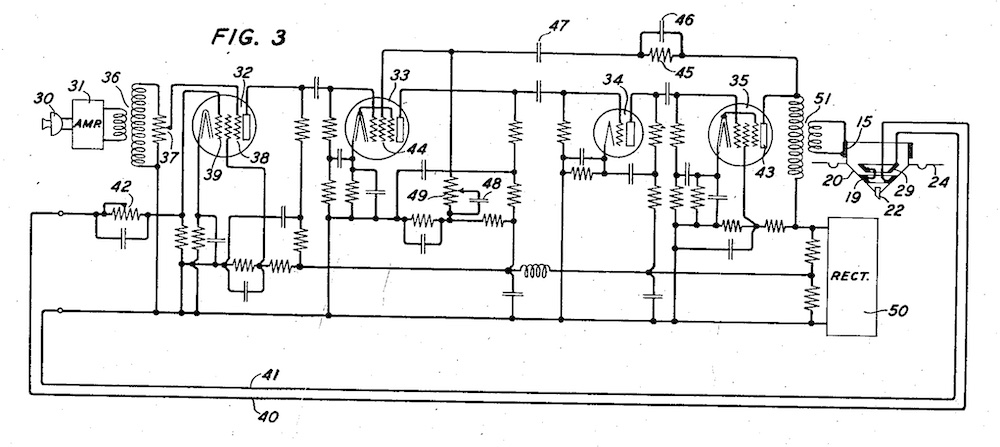
source: “Vibratory System”, US Patent 2,161,489, by Leonard Vieth et al.
縦振動用フィードバックカッターの特許文書に掲載された、フィードバック回路
Feeback circuit diagram for vertical recording cutterhead.
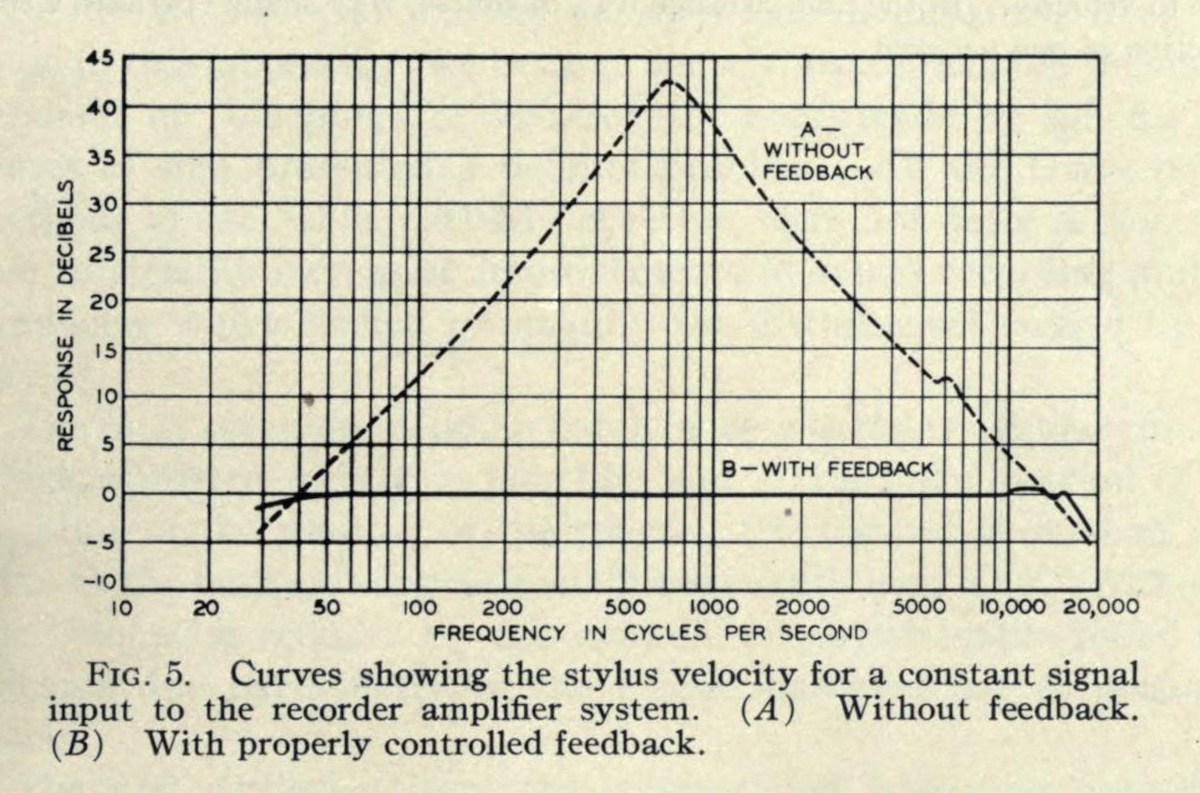
source: “Recent Development in Hill and Dale Recorders”, Journal of the Society of Motion Picture Engineers, January 1938, p.103.
フィードバック回路が備わったカッターヘッドで、フラットな周波数特性での記録が可能に
これにより、30Hz〜12,000Hz でのフラットレスポンスによる記録がついに可能になっています。そして、フラット特性のアンプと合わせて、録音EQカーブを設定する録音用イコライザが初めて完全に独立したことになります。
With this feedback cutterhead, flat frequency recording from 30Hz to 12,000Hz was accomplished. Also, this was the time when the recording equalizer unit was completely independent from the recording cutterhead, accompanied with flat response amplifiers.
現代でも一般的である、通常の横振動記録のレコードで、このモーショナルフィードバックを使ったカッターヘッドが採用されるのは(当連載の後半で紹介しますが)もっと後の1949年のことです。それまでは、横振動記録のレコード録音では、依然として「低域のターンオーバーはカッターヘッドの特性で」「高域のプリエンファシスはEQで」という仕組みを採用していました。
Modern recording systems as well as ordinary “disc records” we are familiar with adopt lateral recording technology. In the world of lateral recording, cutterheads with motional feedback system would appear nearly ten years later. Until then, lateral recording system used “constant amplitude below turnover frequency being accomplied with the characteristic of cutterheads”, plus “treble preemphasis by dedicated EQ units”.
それに10数年先駆けて、ベル研の縦振動システムで、録音EQの独立が実現していたのです。
So the Bell Labs’ vertical recording already integrated the modern-style recording EQ system, getting ahead of lateral recording system for over ten years.
英国の Wireless World 誌の1938年11月28日号では、World Broadcasting System での16インチ縦振動トランスクリプション盤の製造風景が写真入りで “How Electrical Transcriptions are Made: Recording in America by the Vertical Cut (or “Hill and Dale”) Method”” という記事で解説されています。
Nov. 24, 1938 issue of the Wireless World magazine (UK) features the article entitled “How Electrical Transcriptions are Made: Recording in America by the Vertical Cut (or “Hill and Dale”) Method”, featuring photos of the 16-inch vertical transcription recording/cutting session at the World Broadcasting System in Chicago, IL.
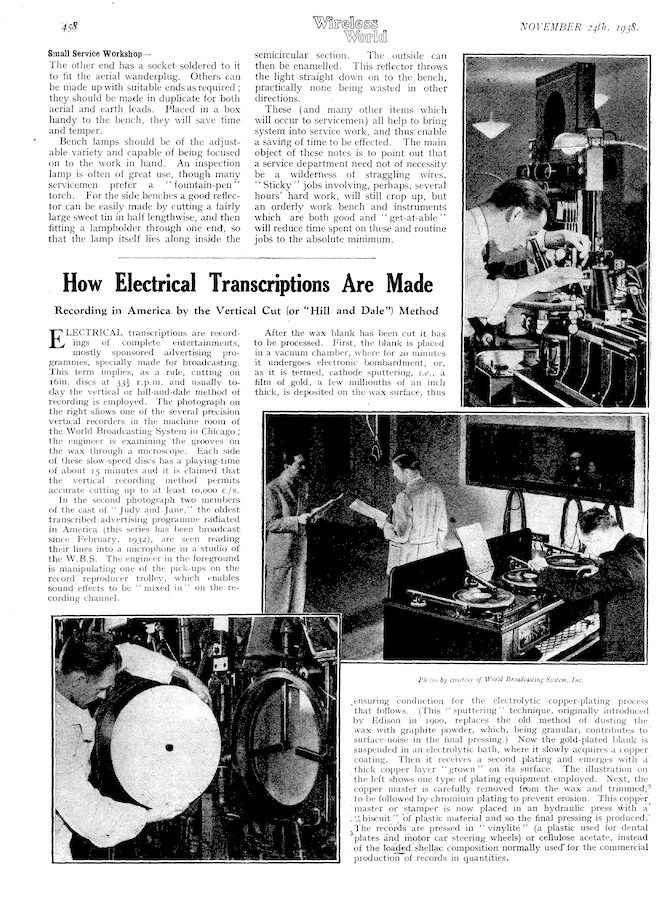
source: “How Electrical Transcriptions are Made: Recording in America by the Vertical Cut (or Hill and Dale) Method”, The Wireless World, Nov. 24, 1938,, p.458.
ベル研では同時に、縦振動盤と横振動盤の両方に対応したピックアップ(再生用カートリッジ)も発明していました。今でいうところのMC型カートリッジで、米国特許 2,034,872 “Phonograph Reproducer” として登録されています。これにより、縦振動トランスクリプション盤と横振動トランスクリプション盤の両方を扱うラジオ局で、1本のトーンアームとピックアップで両方再生可能なソリューションを提供したことになります。
Bell Laboratories also invented the phono pickup (reproducer) that is compatible both with hill-and-dale and lateral cut records, filed as the US patent 2,034,872 “Phonograph Reproducer”, what is now called a kind of MC type phono pickup. This enabled the radio stations having both vertical/lateral transcription discs to play both discs with a single tonearm with this pickup.
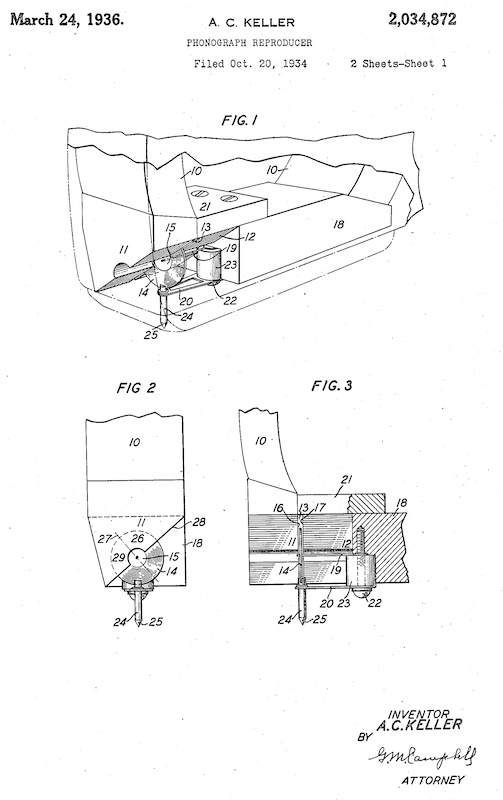
source: “Phonograph Reproducer”, US Patent 2,034,872, Arthur C. Keller, 1936
ベル研の Keller 氏による特許より、縦横振動両対応再生カートリッジの図版
以下、Pt.1 や Pt.3 でも登場した、元AT&T〜ベル研勤務、電気録音最初期にも関わり、トーキー映画用光学式録音システム開発に貢献した、John G. Frayne 博士の国際会議発表 “History of Disk Recording” (Audio Engineering Society, Vol.33, No.4, April 1985, pp.263-266,269-270) から引用します。
Following is quoted from “History of Disk Recording” (Audio Engineering Society, Vol.33, No.4, April 1985, pp.263-266,269-270) by John G. Frayne, ex-AT&T, ex-Bell Labs, who engaged in early electrical recording and also contributed the development of sound-on-film recording system.
The next historic step in recording development was made by Bell Telephone Laboratories in the early 1930s. A completely new system was perfected incorporating the following [4].
(1) A vertical-cut recorder using electrical feedback was to eliminate mechanical resonance. (…)
(2) Flowed hot wax disks were used in place of the large wax plates.
(3) Gold sputtering of the recorded wax was used in the plating process.
(4) Pre- and post-equalization were used to increase the signal-to-noise ratio.
(5) Acetate pressings replaced the old shellac disks.
録音技術において、1930年代にベル研によって開発されたシステムが、次の歴史的な一歩となった。この全く新しいシステムは、以下に述べるような5つの特徴によって構築されていた。
(1) 縦振動記録のシステムであり、かつ、電気的なフィードバックを用いてカッターヘッドの共振特性を排除、周波数特性をフラットにする。(…以下省略)
(2) 厚いワックス盤の代わりに、金属板の表面に薄いワックス面を構成した盤を使用。
(3) ワックス原盤からマスター盤を生成する際、スパッタリング法でワックス原盤に金を成膜する。
(4) S/N比向上のため、録音時のイコライズ、再生時のイコライズを使用。
(5) シェラックではなく、アセチルセルロース(セルロースアセテート)を使ってプレス、盤を製造。
ベル研の縦振動記録レコードについて、Mark Clark 氏が 1993年 AES ベルリン大会でプレゼンした内容のプレプリントにも記されています。
Another mention of vertical cut records can be read in “Audio Technology in the United States to 1943 and Its Relationship to Magnetic Recording” by Mark Clark, presented at the 94th Convention 1993 in Berlin:
Drawing on the Vitaphone experience, Bell Laboratories developed a new phonograph system in the early 1930s. This new system used a vertical cut recorder, coupled with extensive pre- and post-equalization, to achieve significant improvements in signal to noise ratio. This system was used in Hollywood and to record transcriptions of radio broadcasts until the arrival of maginetic tape after World War II.
ヴァイタフォンでの経験を生かし、ベル研究所は1930年代初頭に新しいディスク録音システムを開発した。この新システムでは縦振動記録が採用され、さらに録音時/再生時のイコライズが徹底して使用されていた。この両者により、S/N比を大幅に向上させることができた。第二次世界大戦後に磁気テープが登場するまでの間、ハリウッド内やラジオ放送用トランスクリプション盤として使用された。
Audio Technology in the United States to 1943 and Its Relationship to Magnetic Recording (Mark Clark, 1993)このように、Bell Labs / Western Electric による縦振動トランスクリプション盤で試みられた技術は、のちのマイクログルーヴLP盤に通じる技術革新が多く含まれていました。
As we have learned and seen above, Bell Labs / Western Electric vertical transcription recording system consisted of many technical innovations that made modern long playing microgroove records possible in later years.
同時に、このベル研の試行錯誤や研究開発には、ひとりの偉大なアーティスト(指揮者)が大きく関わっていました。次回はその辺りから話を始めます。
Also, it is incredibly interesting that one great artist (conductor) was extensively involved in the Bell Labs’ trial-and-error, researches and development. I will write the episode in the coming article.
4.5 The summary of what I got this time / 自分なりのまとめ
今回も予想以上に長くなってしまいました(笑)。トーキー映画用の Vitaphone、市販用長時間再生レコード Program Transcription と新素材 Victrolac、ラジオ局用トランスクリプション盤の登場、そしてベル研/WEの縦振動記録トランスクリプション盤の技術革新まで書きました。Galo 氏の論文にある、以下のイラストの世界が、民生用ではなくプロ用ではありますが、ついに登場しました。
Well, in this Part 4 article (yet again, it became a way longer than I initially intended…), I have learned so many things about the “Vitaphone” sound-on-disc recording system for Talking Motion Pictures; long playing Program Transcription records for consumer market; new material Victrolac; Electrical Transcription discs for radio industry; Bell Labs / Western Electric’s innovative vertical (hill-and-dale) recording system. Finally, at this time, the world of modern “equalization curve”, like shown in the illustration from the famous G.A. Galo’s article, has finally surfaced, although it was for professional purpose, not for consumer market.
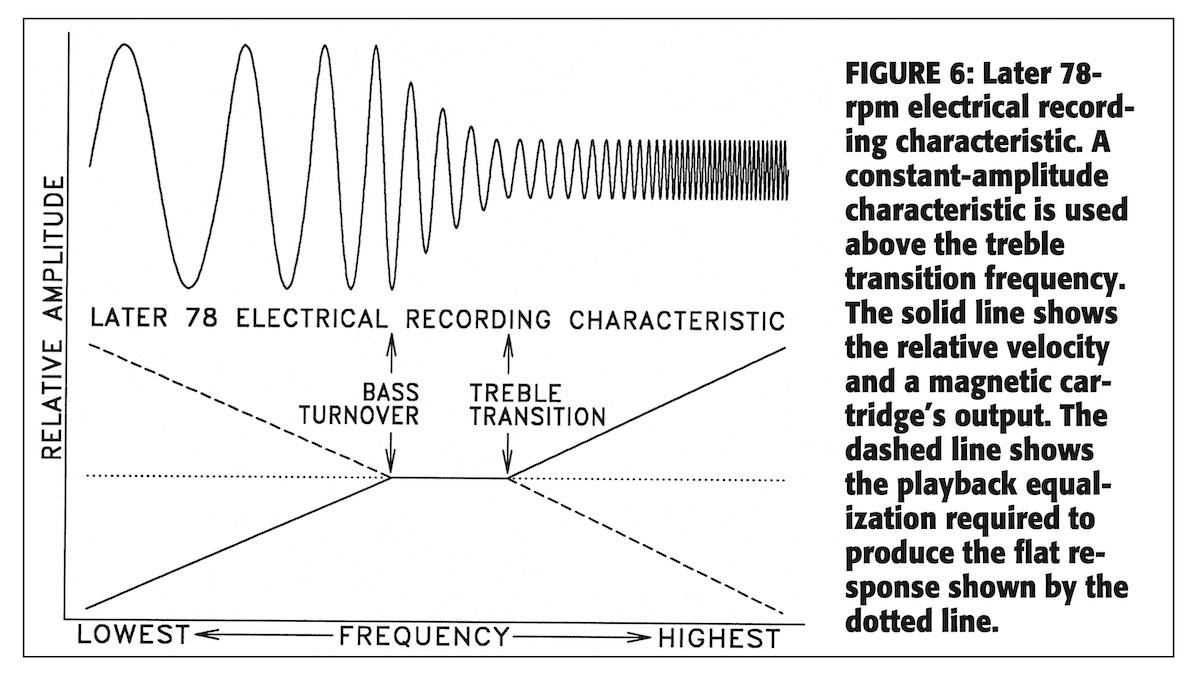
source: “Disc Recording Equalization Demystified”, The LP Is Back!, p.45-54, audio express website (1999)
ベースターンオーバー周波数に加え、高域トランジション周波数も登場した場合の録音カーブ(実線)
低域ターンオーバー周波数より下と、高域トランジション周波数より上が定振幅、間が定加速
点線が再生カーブに相当する
さてさて、今回の内容をざっくりまとめると、こんな感じでしょうか。
…so, the rough summary of my understanding in this article would be something like this:
元々はトーキー映画の音声用に作られた33 1/3回転の Vitaphone の技術を使い、RCA Victor が市販用に長時間レコード Program Transcription を販売開始したが、当時の技術では問題があり、また大恐慌真っ只中でもあり、ほどなく回収された。一方、ラジオ局を中心に16インチトランスクリプションが多く使われるようになり、事実上業界標準のメディアとなった。
RCA Victor’s long playing 33 1/3 “Program Transcription” discs and associated players debuted for commercial customers, using the technology of Vitaphone, a successful soundtrack system for moving pictures. However, “Program Transcription” system had several defects, and it was during the Great Depression. So it was abandoned a few years later. On the other hand, this 33 1/3 coarsegroove disc technology survived as Radio Station Transcription discs and became an industry standard.
1931年に登場した民生用の RCA Victor 長時間レコード Program Transcription 盤では、Victrolac (Vitrolac) という新素材を使った盤が使われた。のちのヴァイナル盤につながる合成樹脂で、これにより盤が軽量化し、割れにくく、サーフェスノイズも減った。ただし、当時主流だった重いピックアップと鉄針では、盤がすぐに痛んでしまった。
RCA Victor’s long playing Program Transcription records (for consumer market, debuted in 1931) used Victrolac compound, which was the first attempt to use symthetic resin for disc records like vinyl records of PVC compound in later years. Victrolac disc was lightweight, unbreakable and with less surface noise. However, because of the heavy pickup and steel needle (that was very common in those days), it was worn out very easily.
ほぼ同時期に、Bell Labs / Western Electric が、縦振動記録の新方式を開発、セルロースアセテートにプレスする方式で、当時としては画期的な音質向上に寄与する技術がいくつも採用された。そのなかのひとつが、S/N比向上のために採用された高域プリエンファシスの定義で、現在につらなる録音再生カーブの最初期の例となる。
Also in the early 1930s, Bell Labs / Western Electric developed a new “hill-and-dale” (vertical) recording system and acetate pressing. This system adopted many technical innovations that contributed sound quality improvements. One of them was the introduction of intentional treble preemphasis, that was one of the early example of modern recording/reproducing EQ curve.
また、縦振動トランスクリプションでは、1938年にモーショナルフィードバック回路を備えたカッターヘッドが開発され、フラット記録が可能となった。この時点で初めて、録音EQカーブが独立した装置で設定されるようになり、通常の横振動レコードの10年近く先を行く画期的な発明であった。
Bell/WE also invented the feedback cutter for vertical transcription system, that accomplished flat frequency response recording. This technology, for the first time in history, opened the door that the recording EQ became independent from cutterhead’s characteristic. It was such an innovation that made the system nearly ten years ahead of lateral recording system.
次回は引き続き歴史を辿り、Stokowski の貢献、RCA/NBC と1939年に発表された Orthacoustic 記録特性あたりについて学んでいきます。
My next post will feature the continuing history, including the contribution by Mr. Stokowski, RCA/NBC and Orthacoustic recording characteristic debuted in 1939.
» 続き / Sequel: “Things I learned on Phono EQ curves, Pt.5” »

